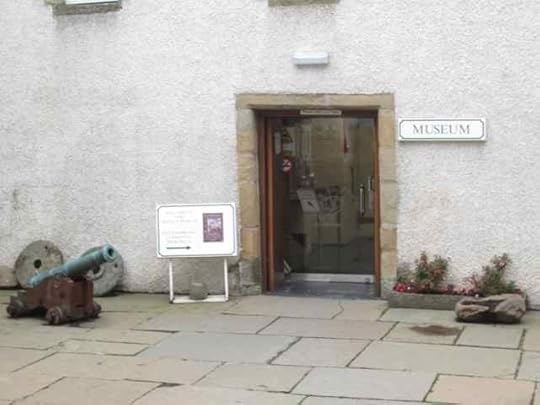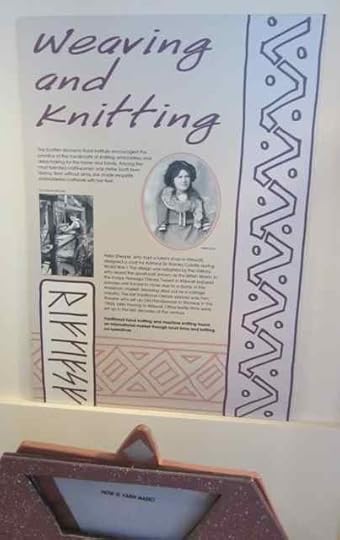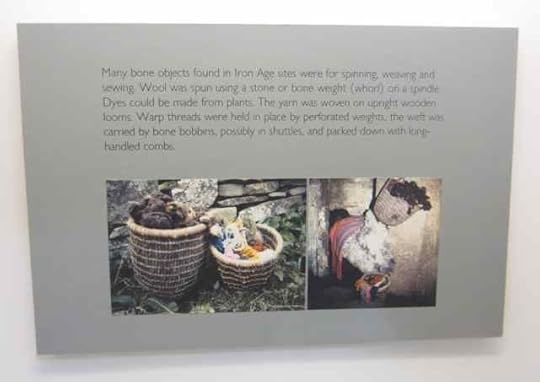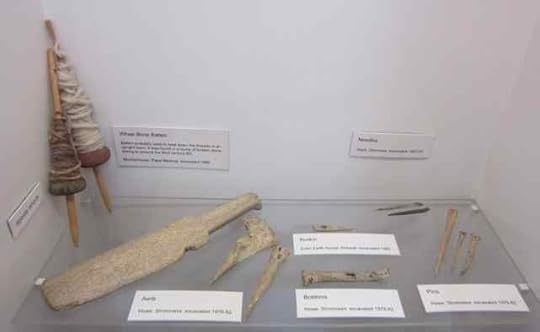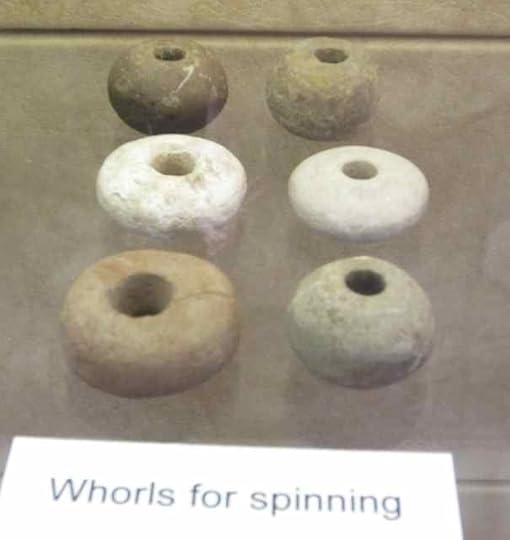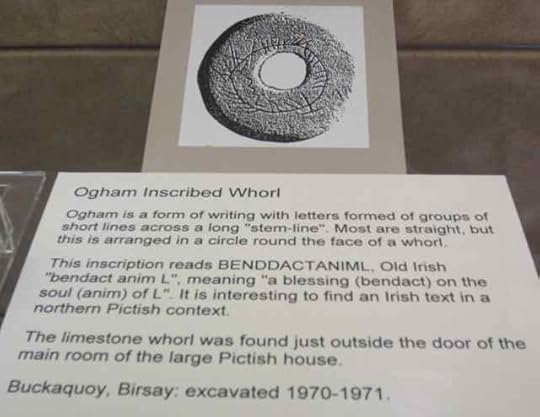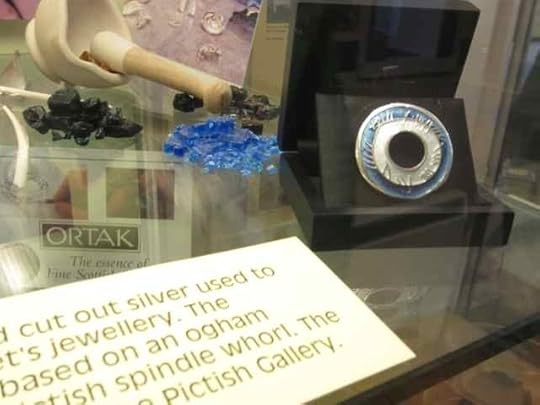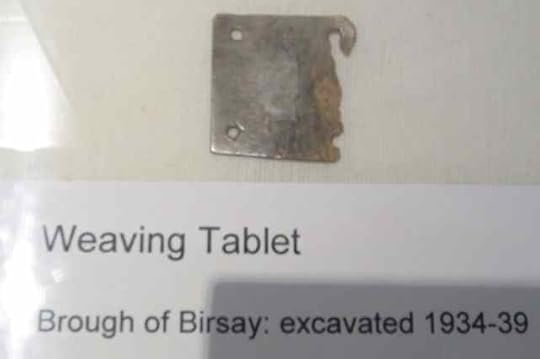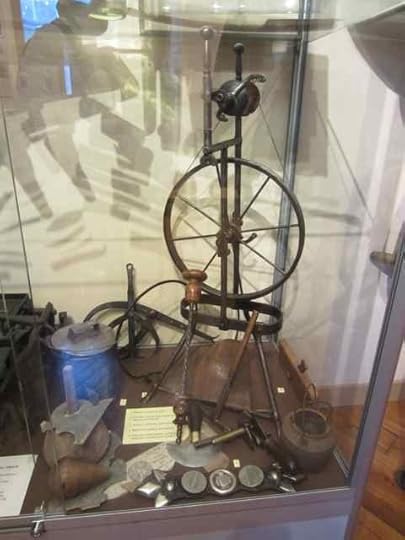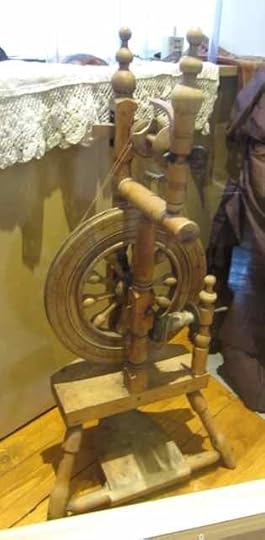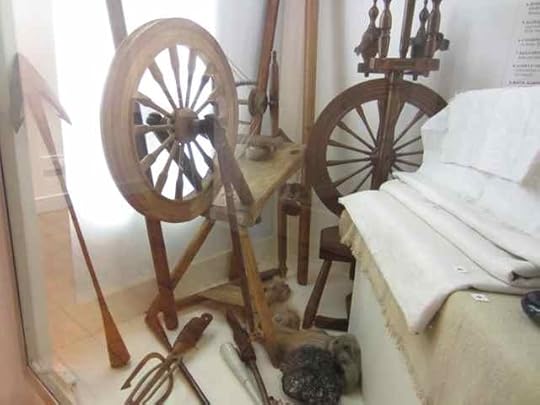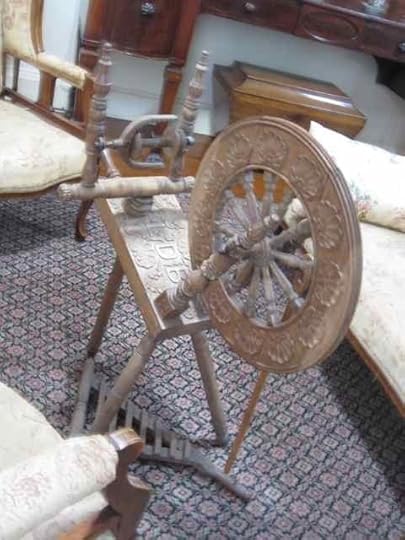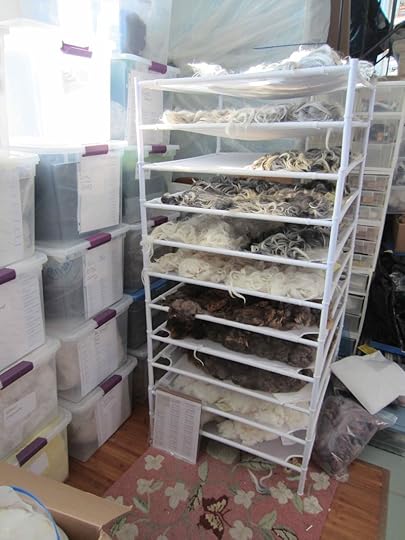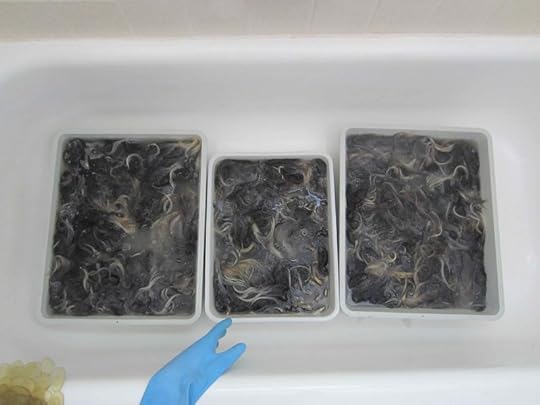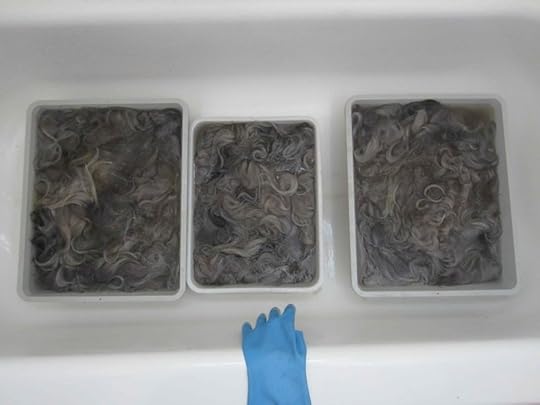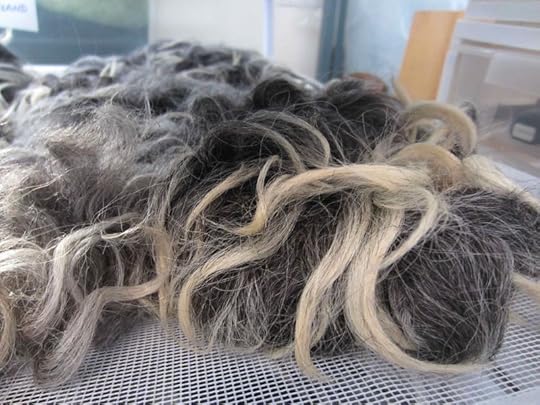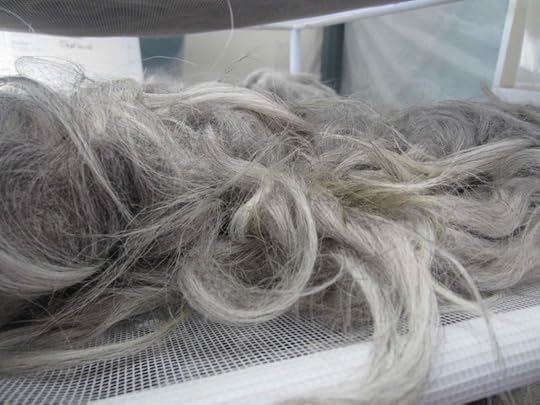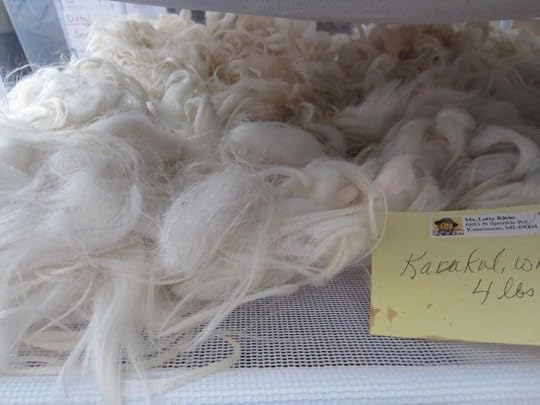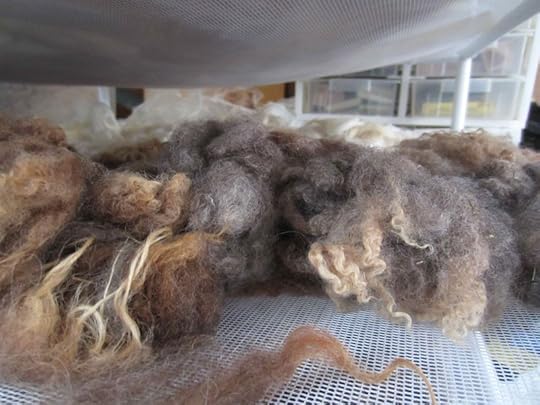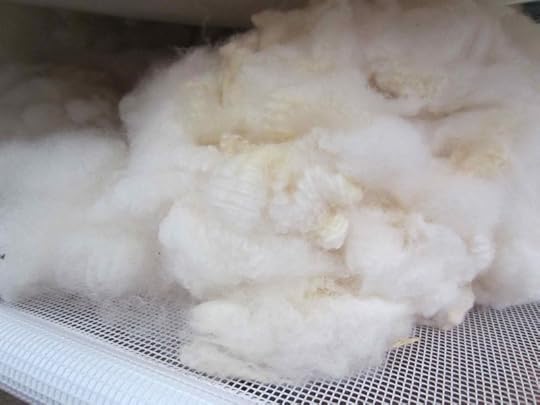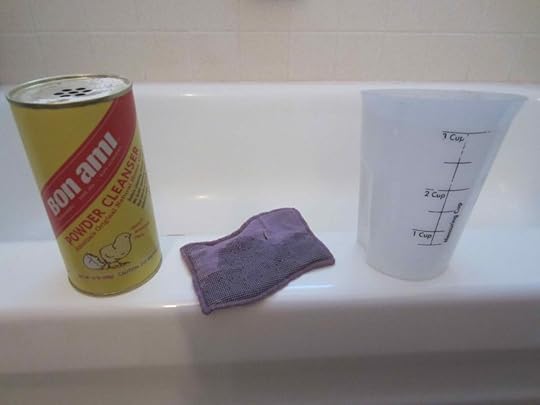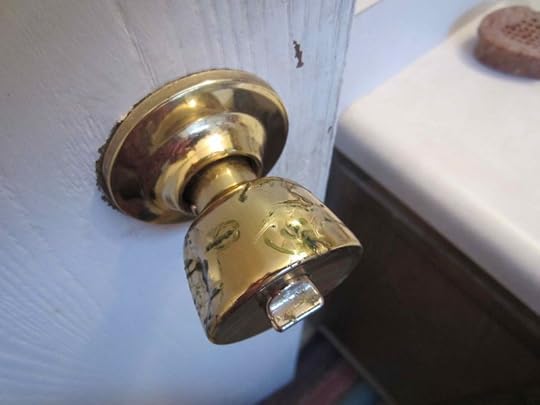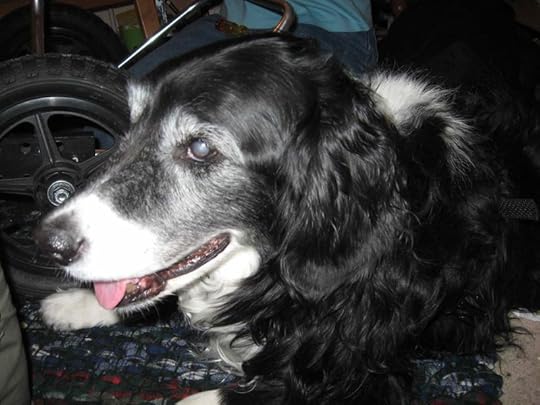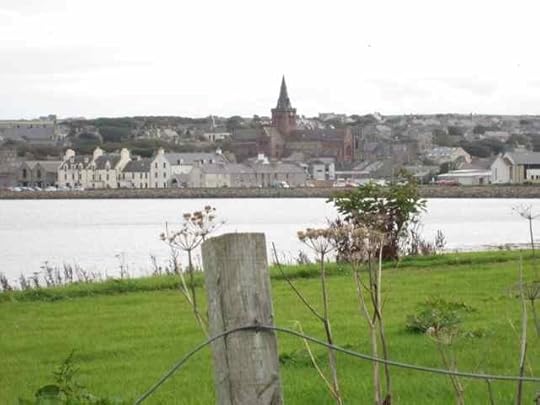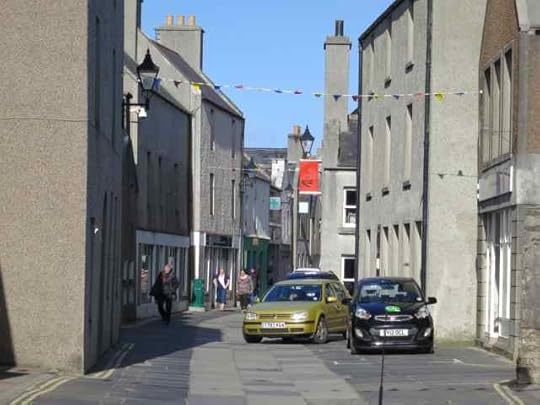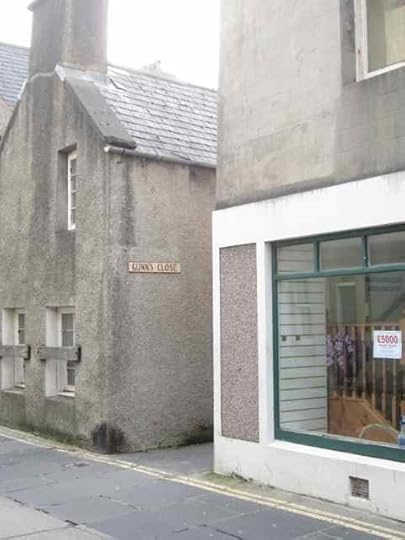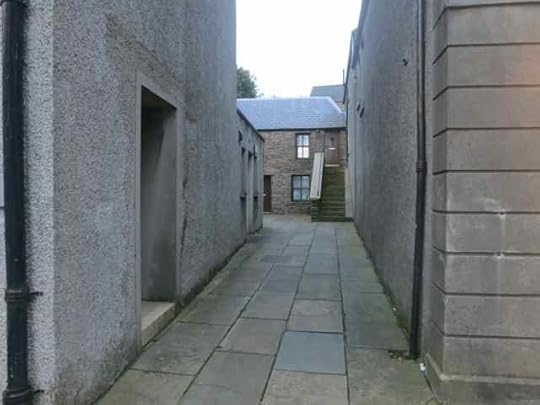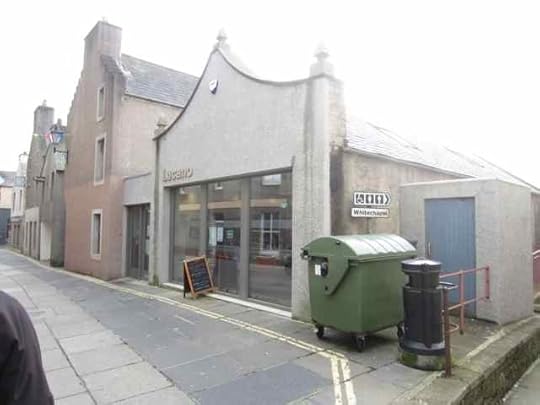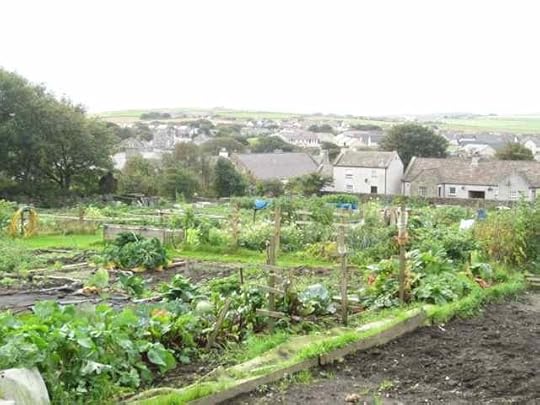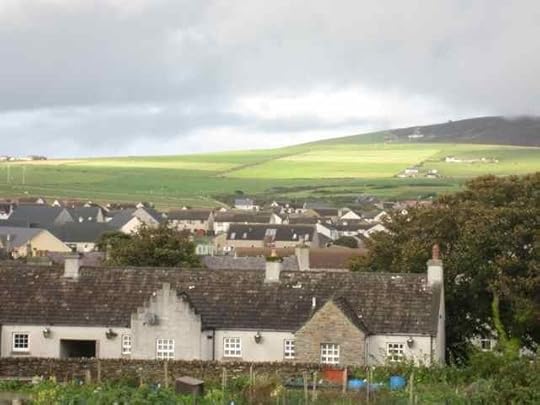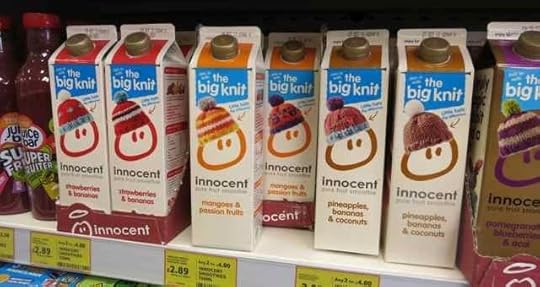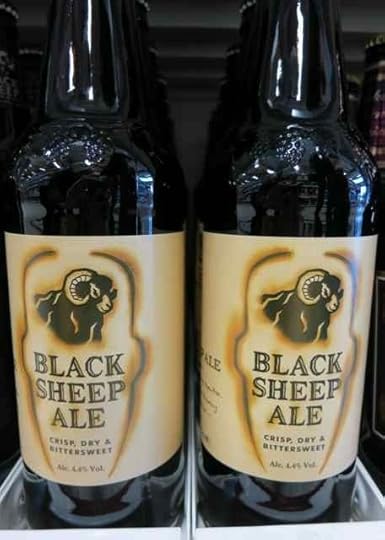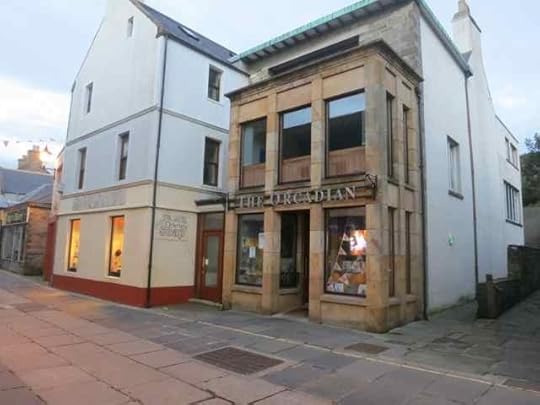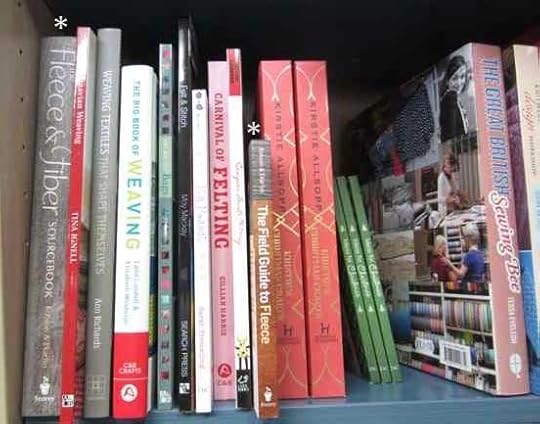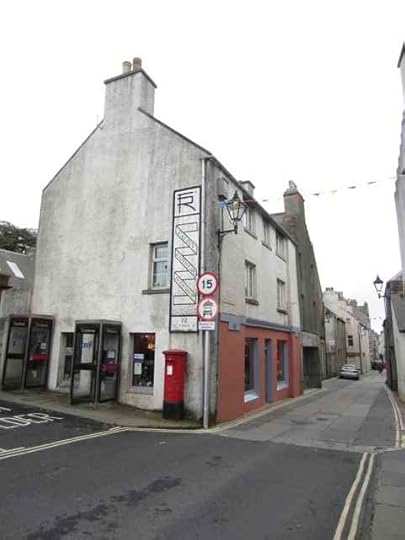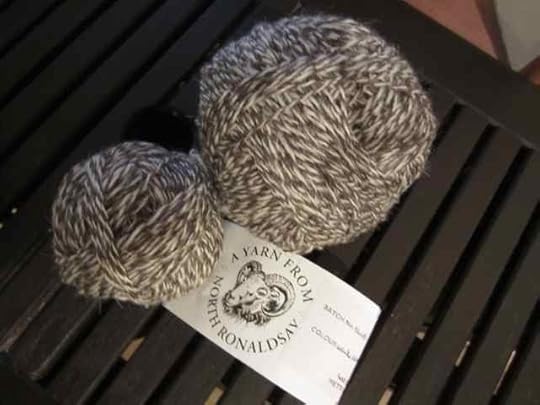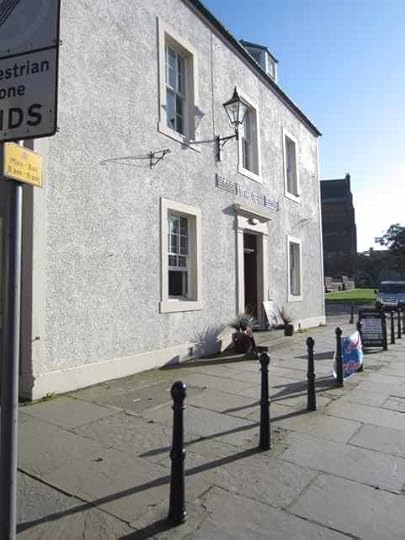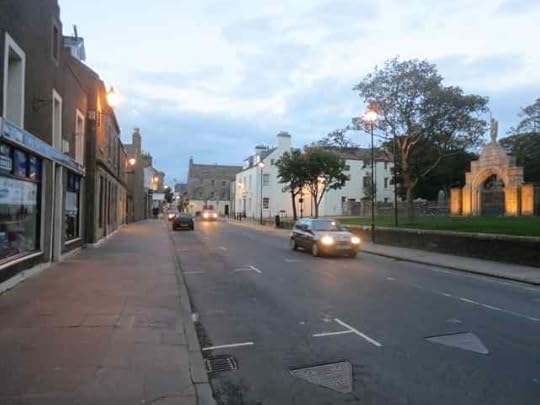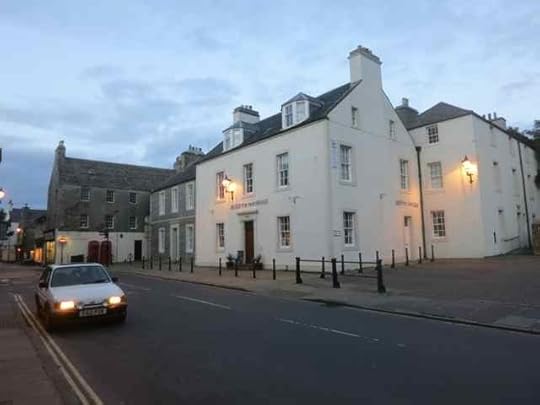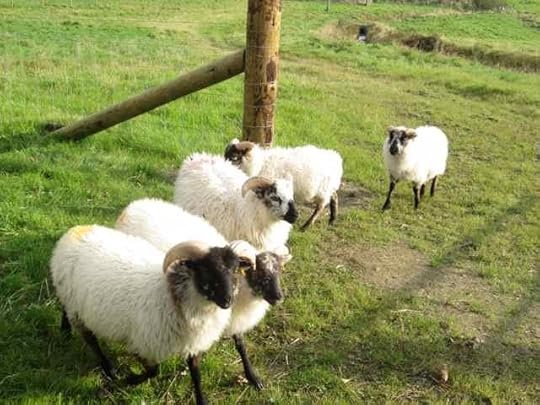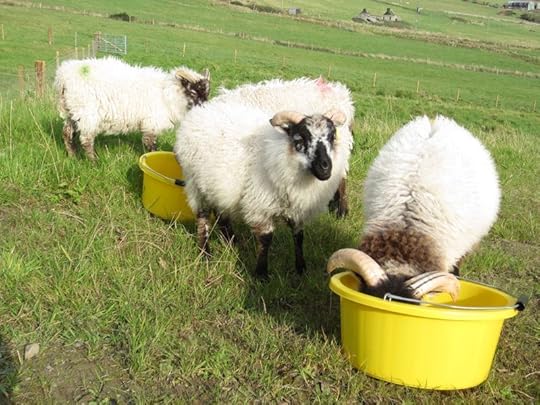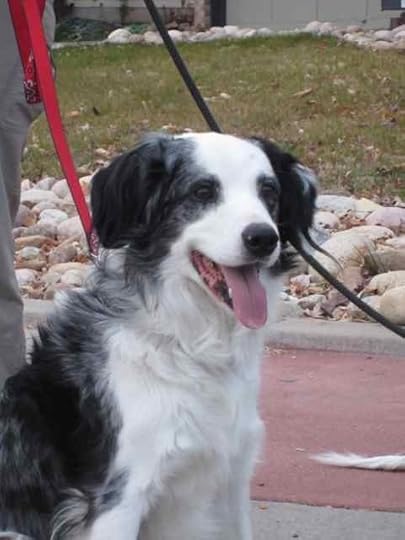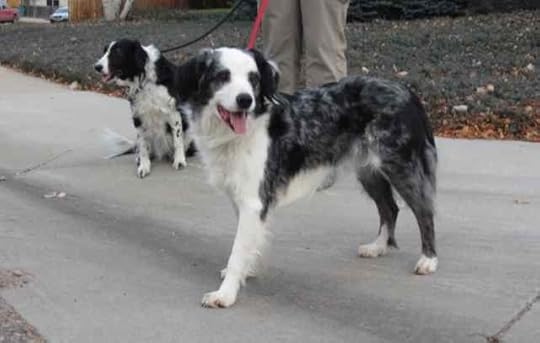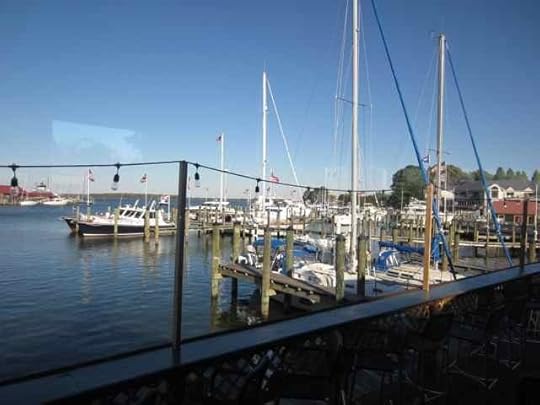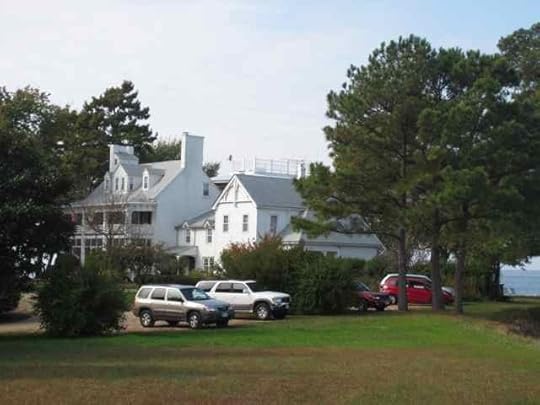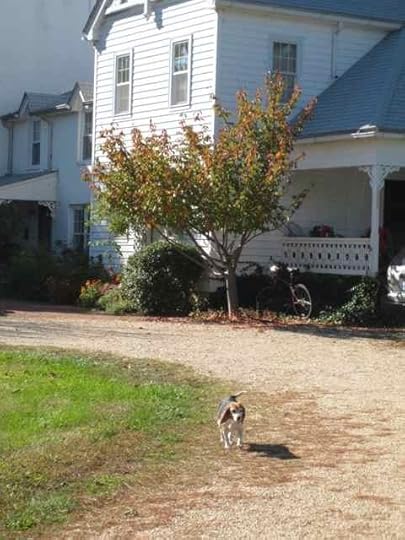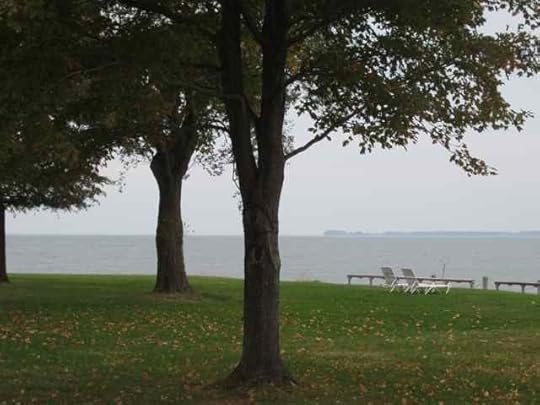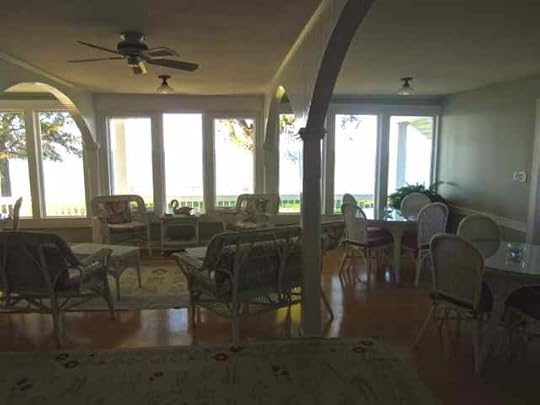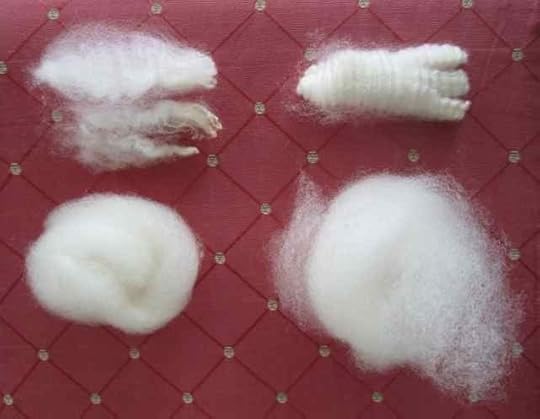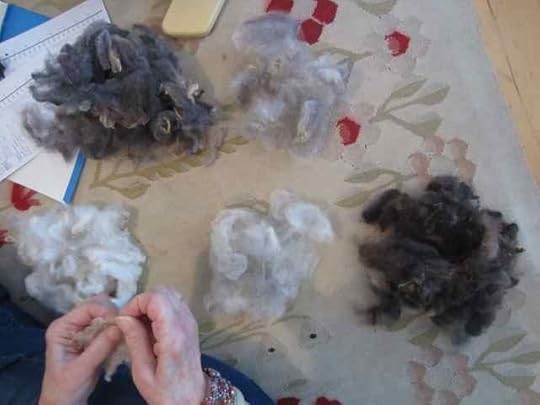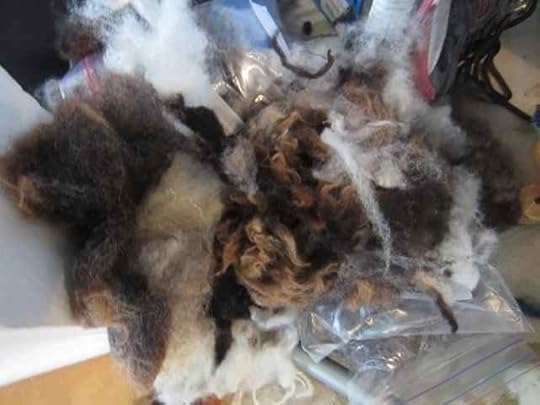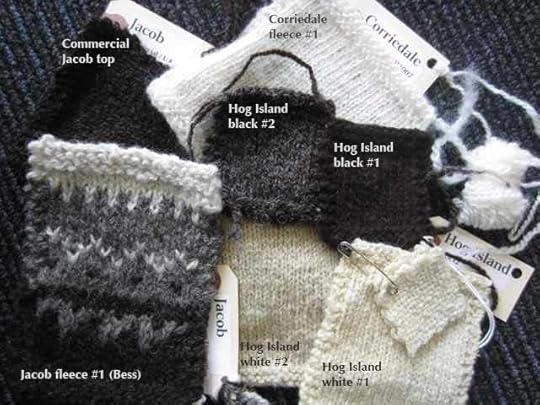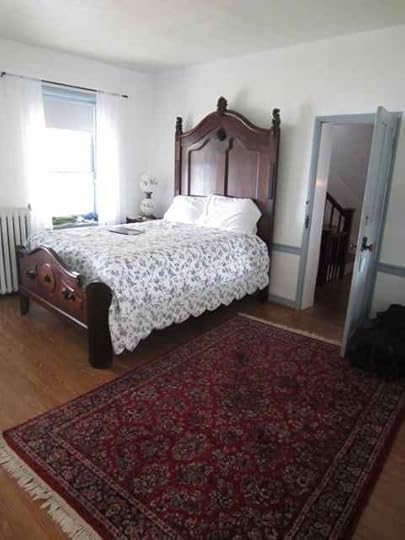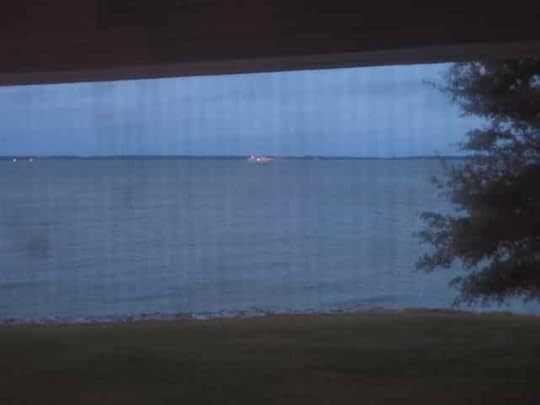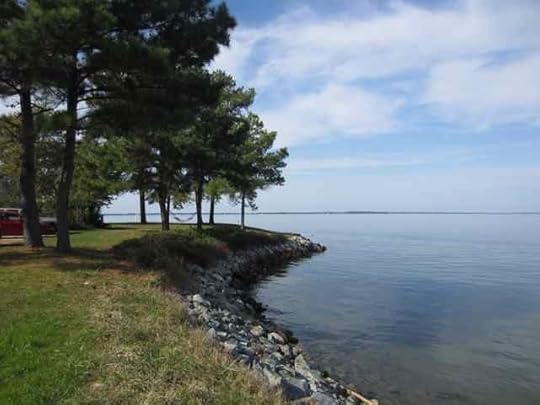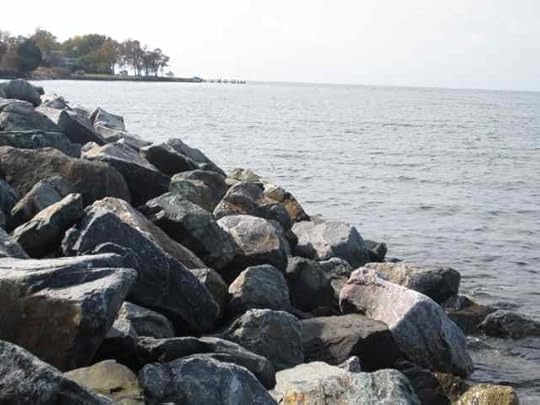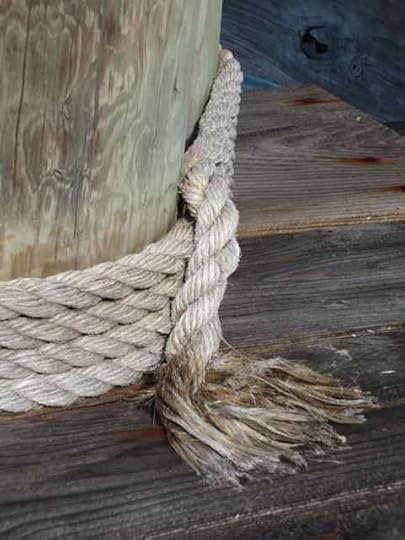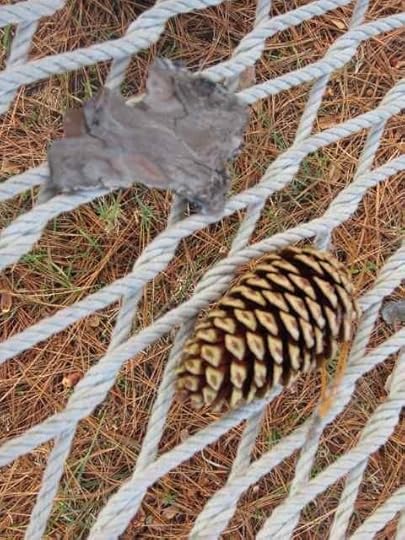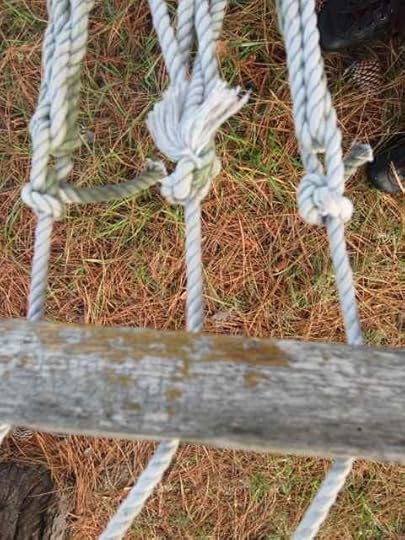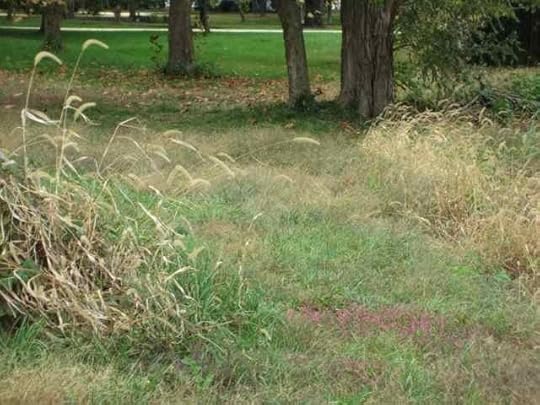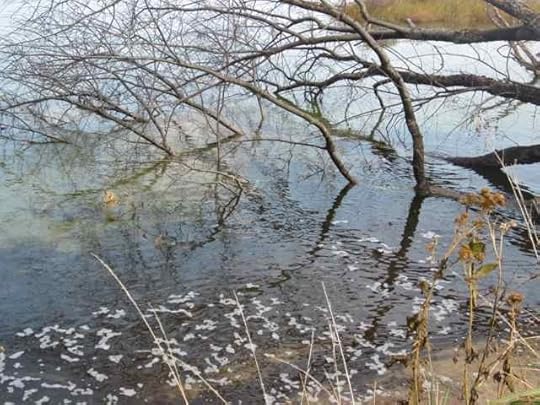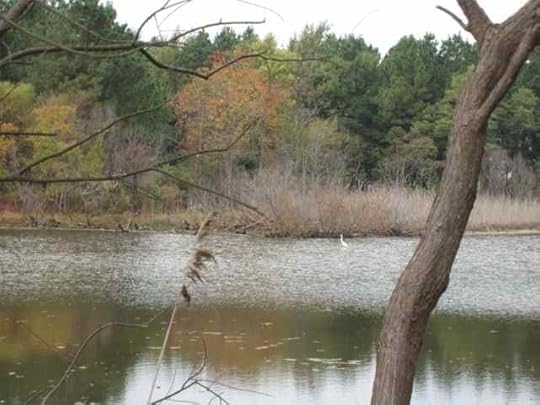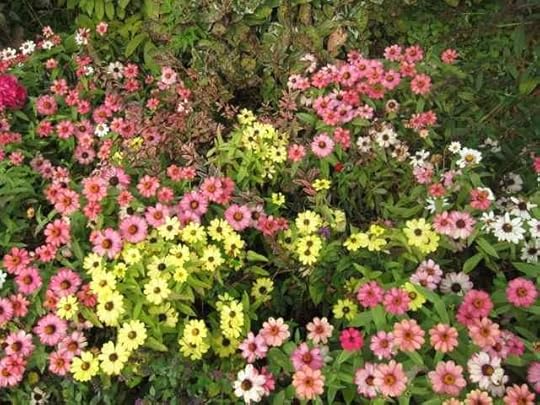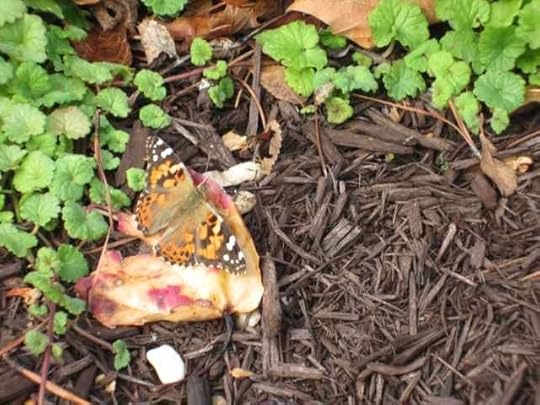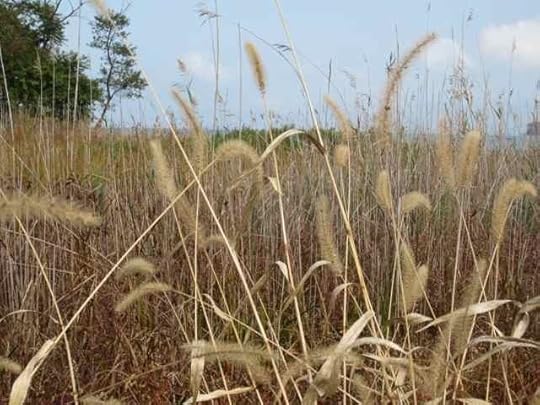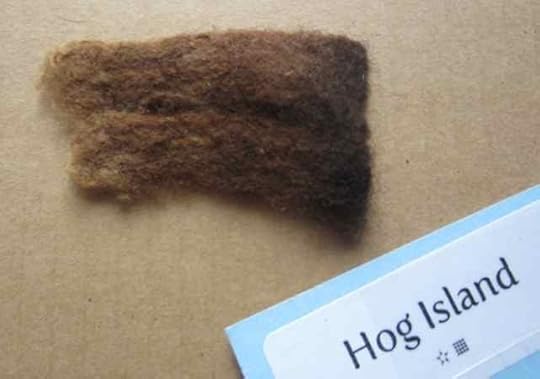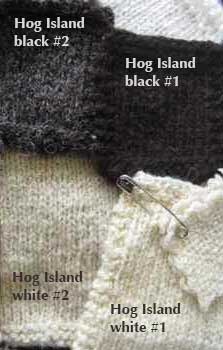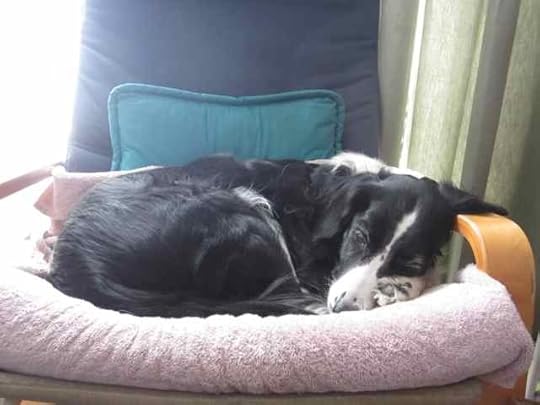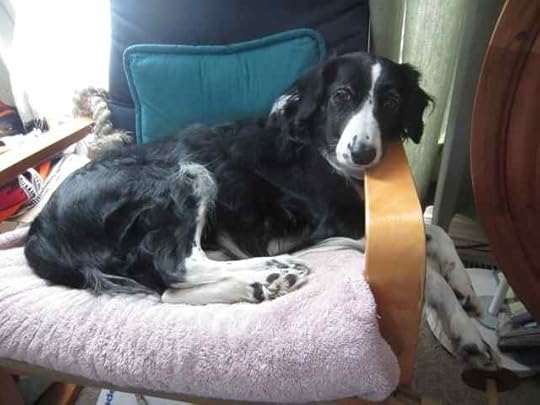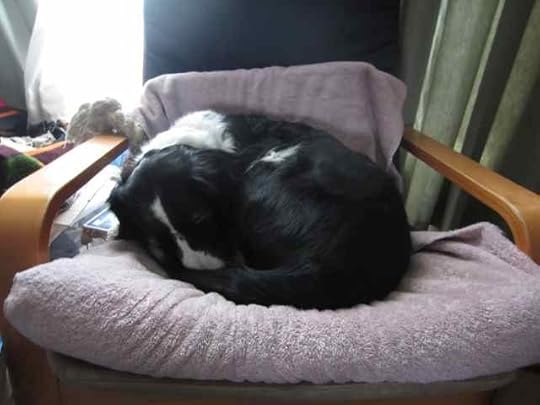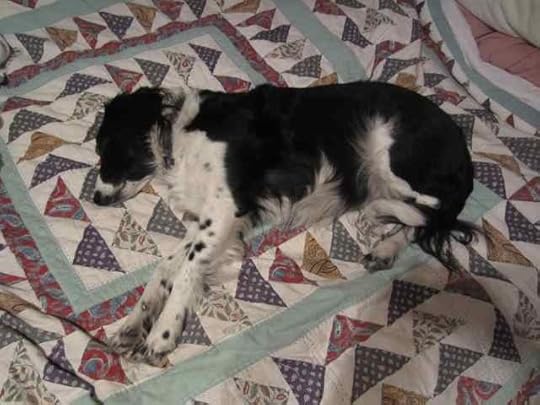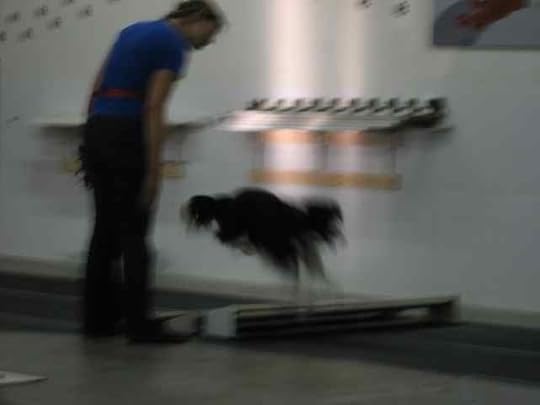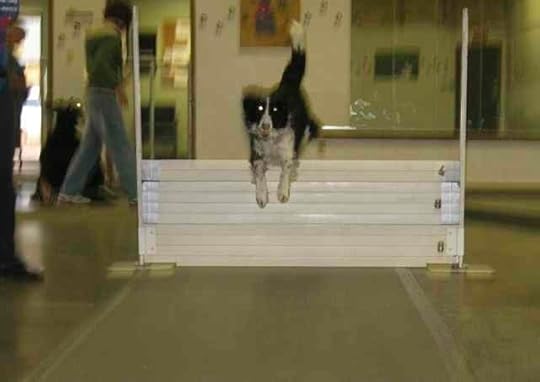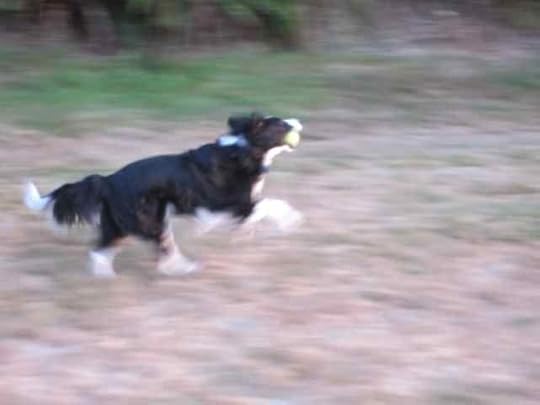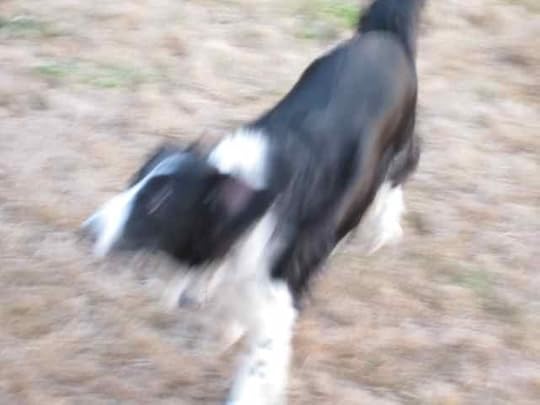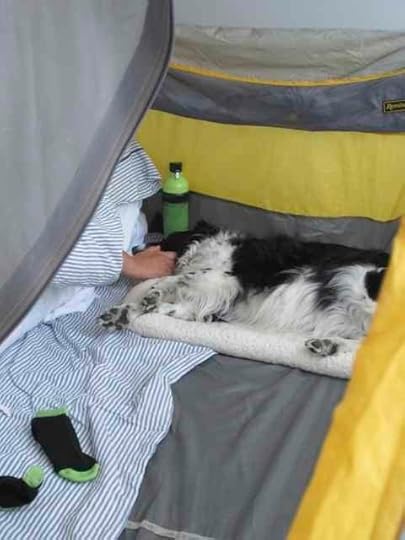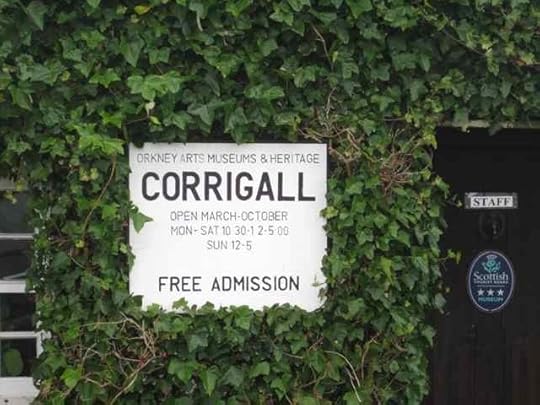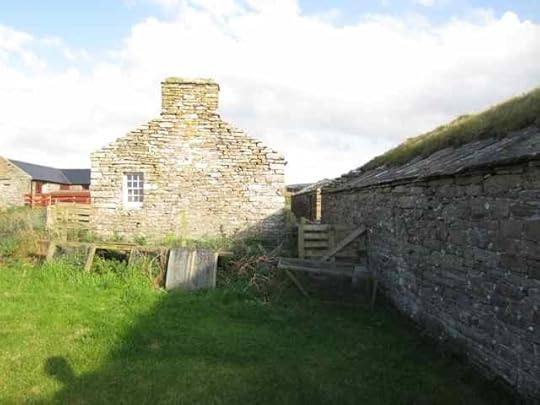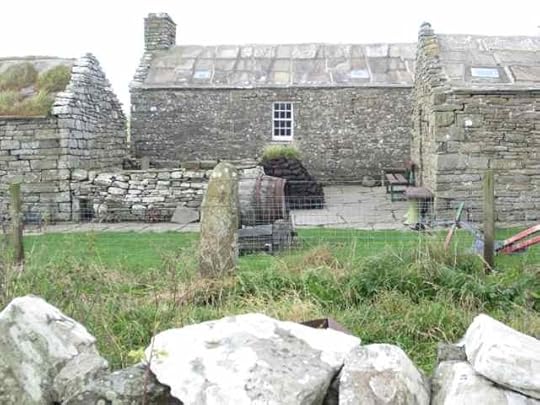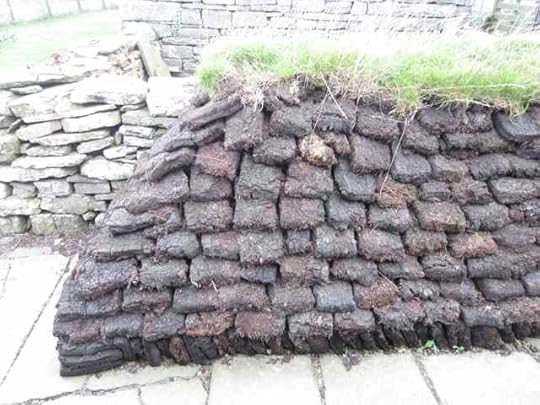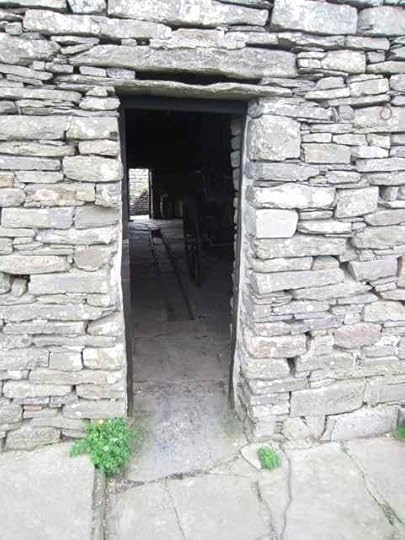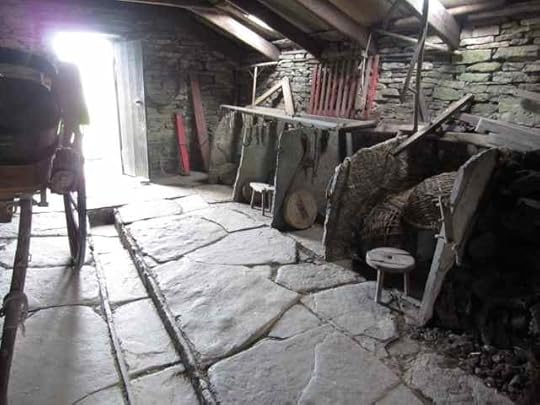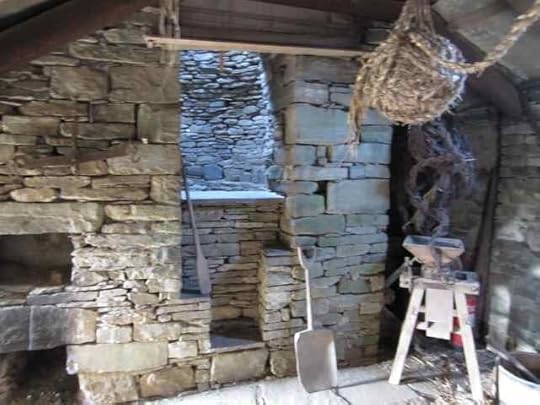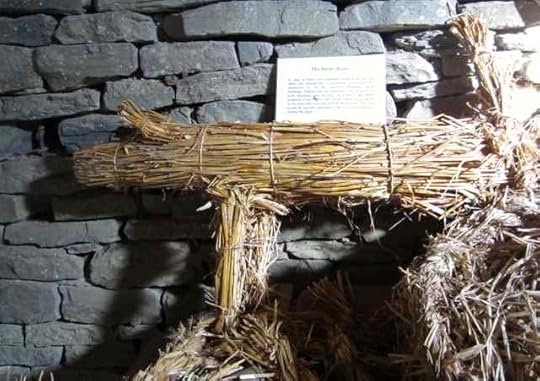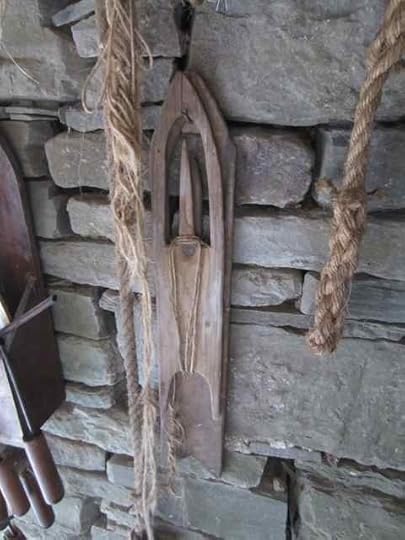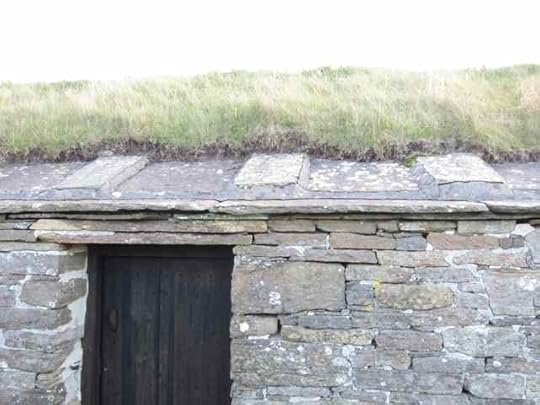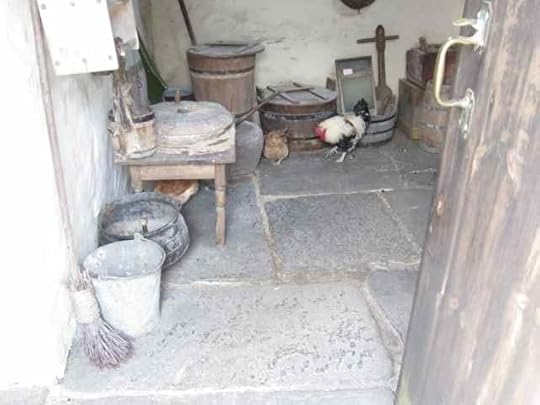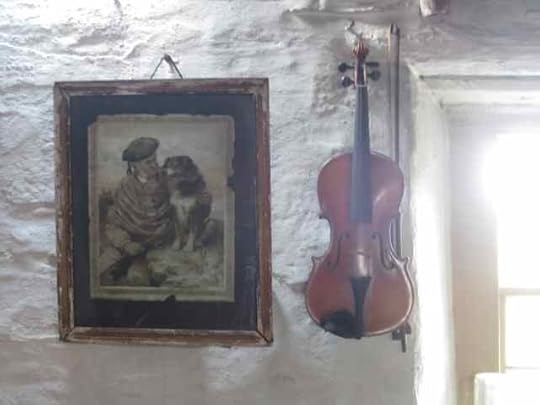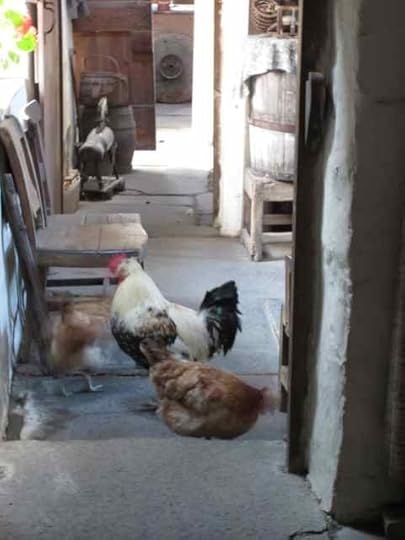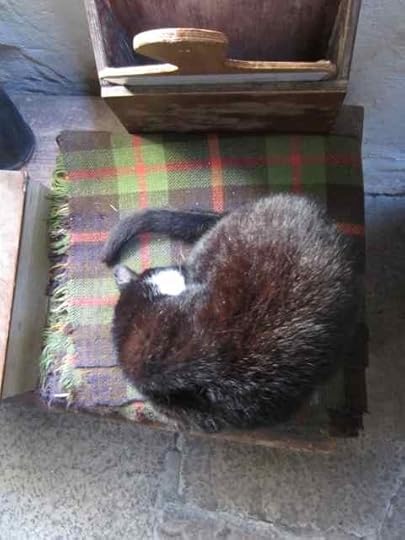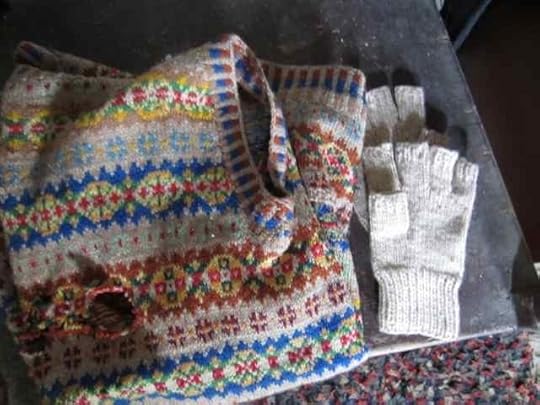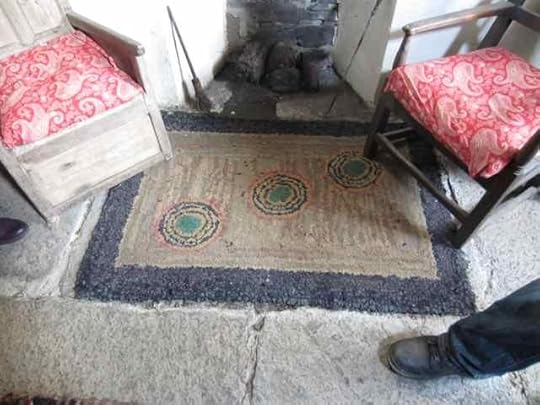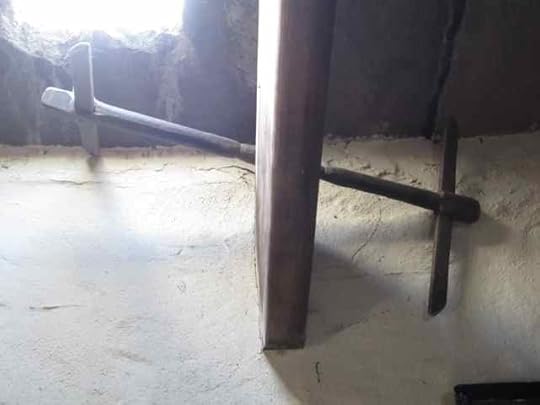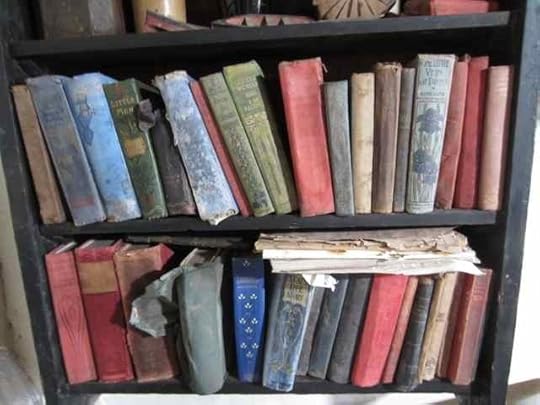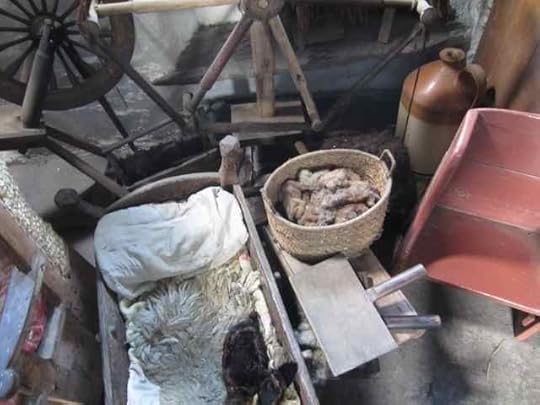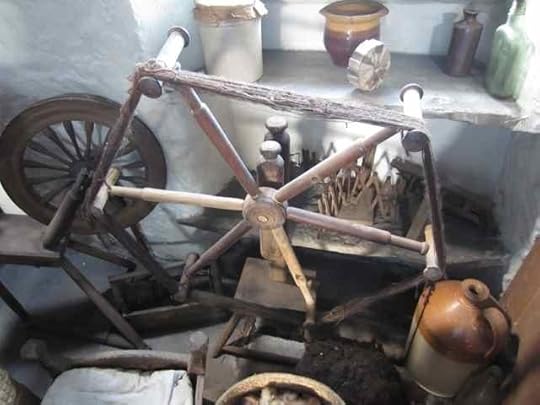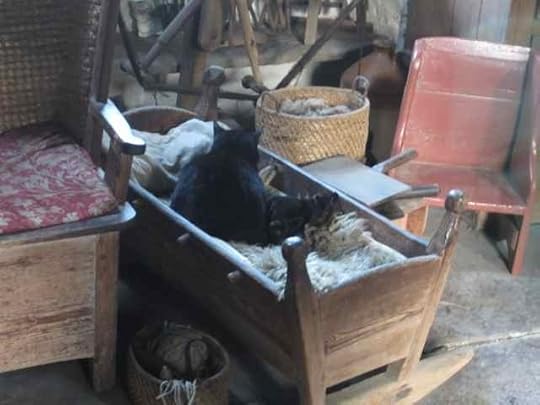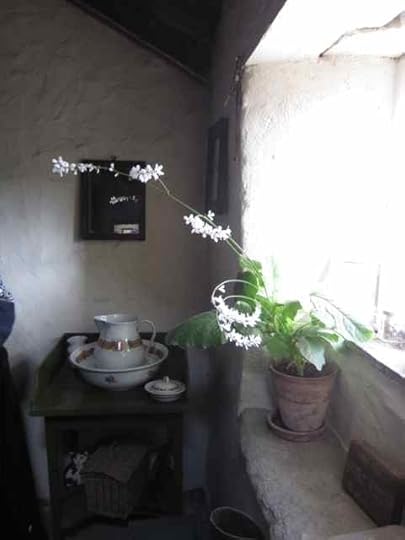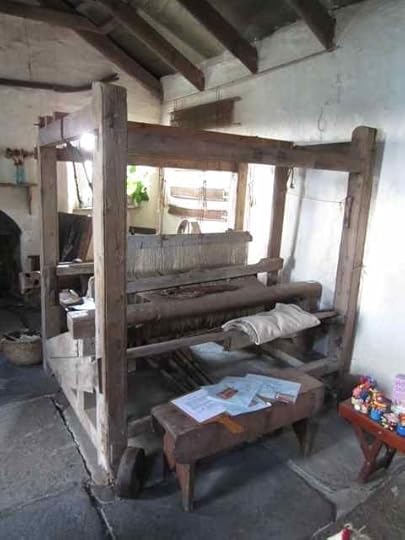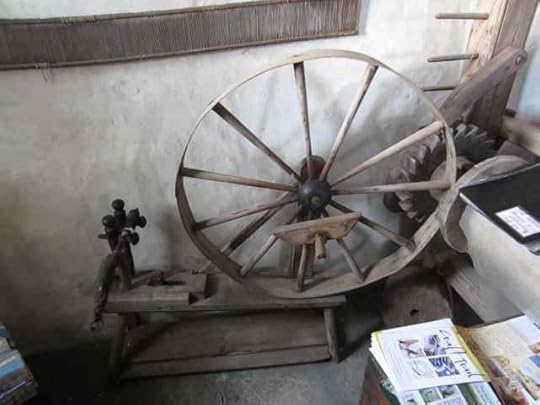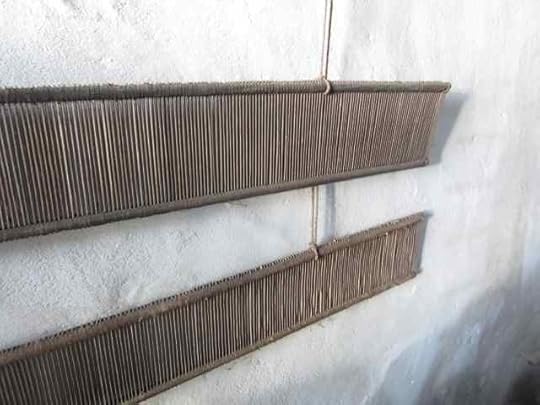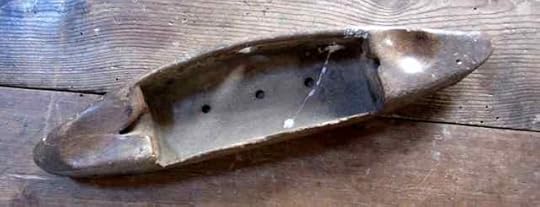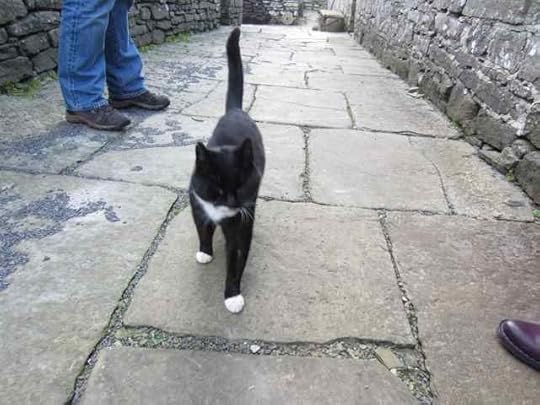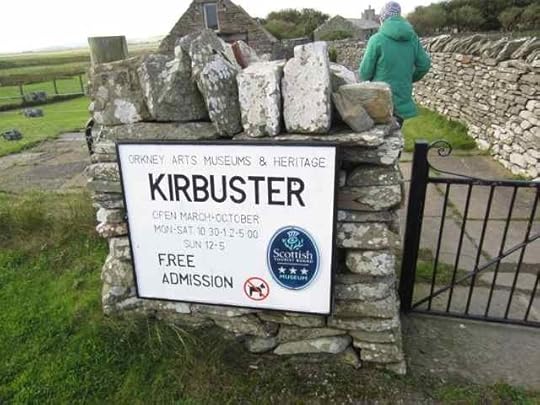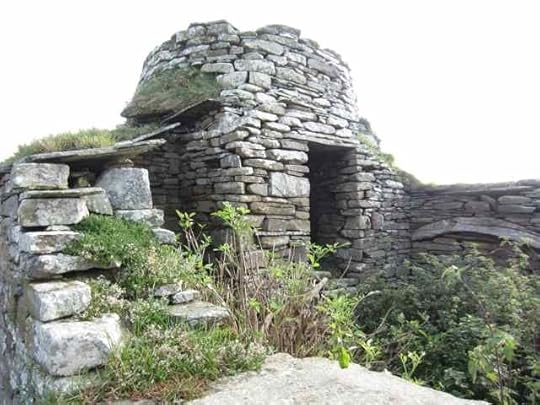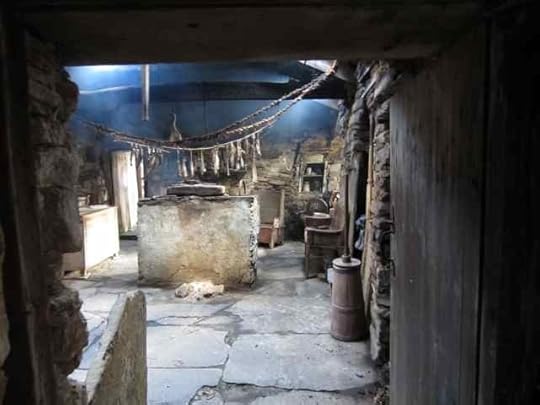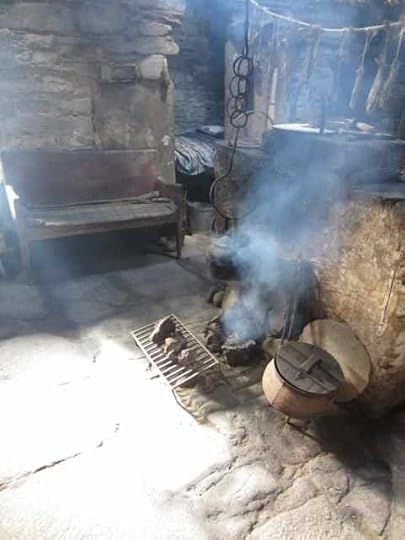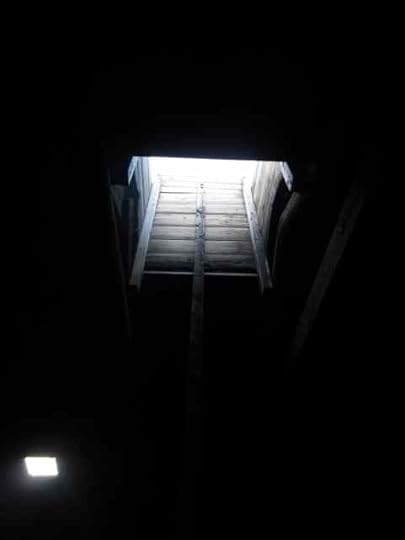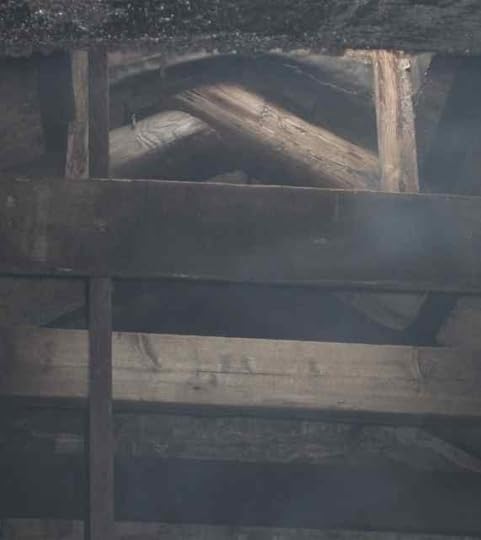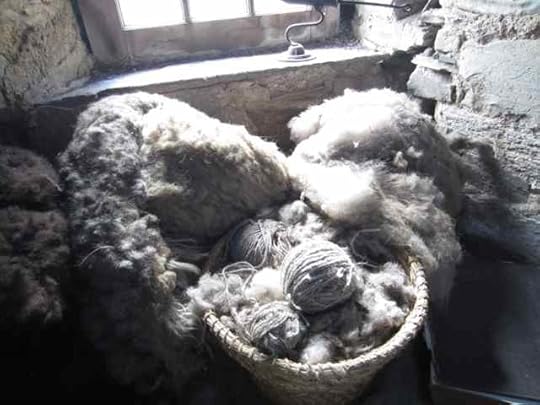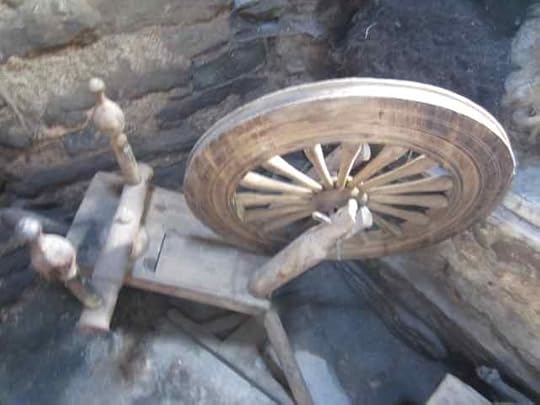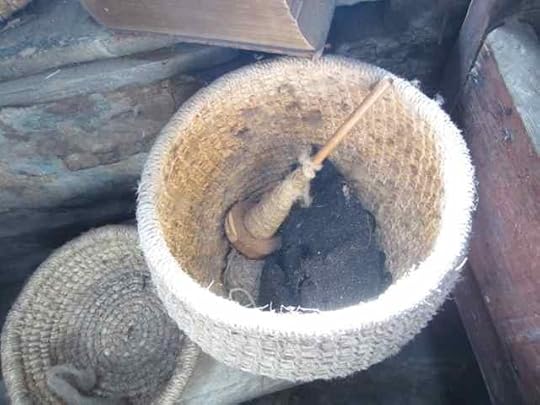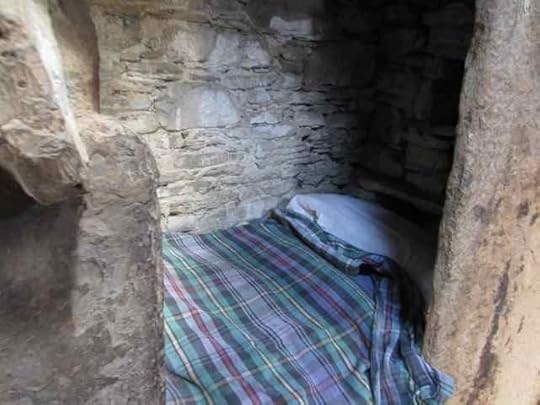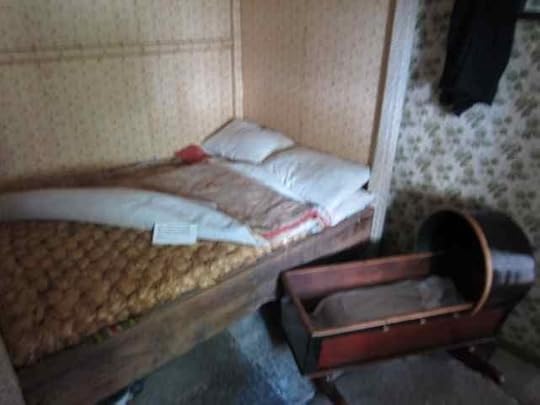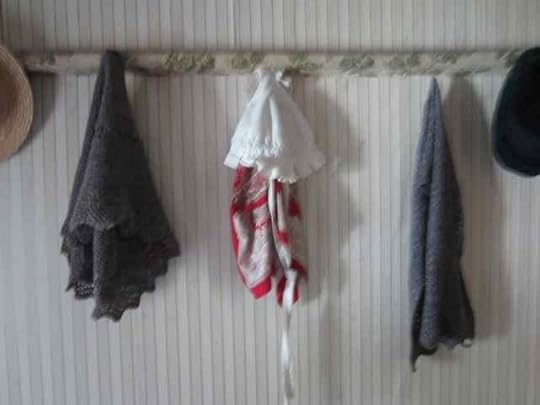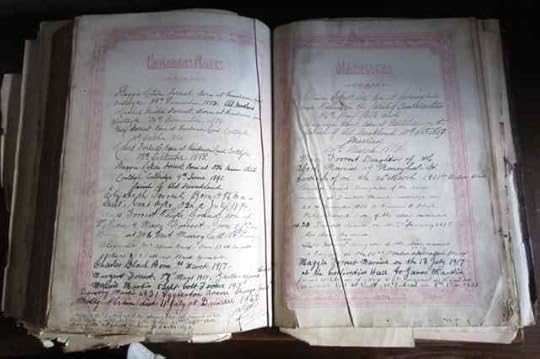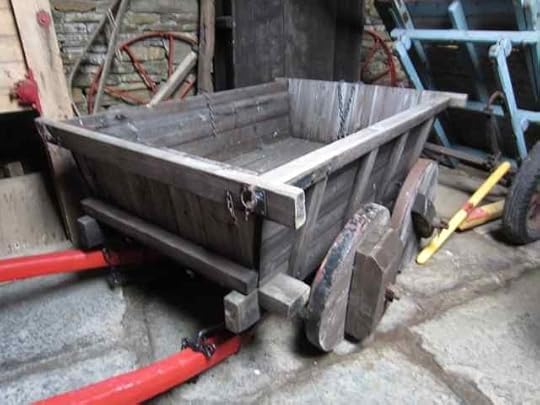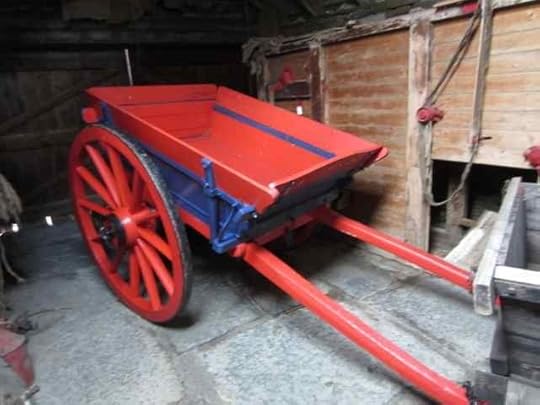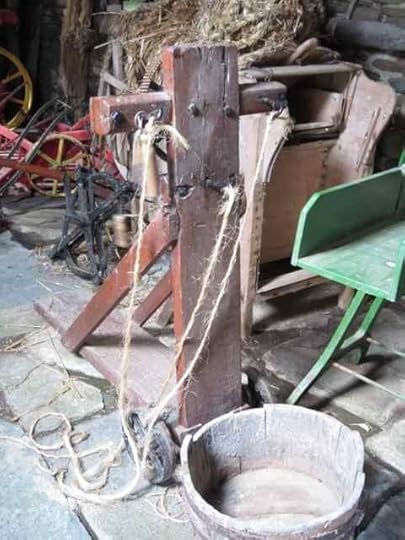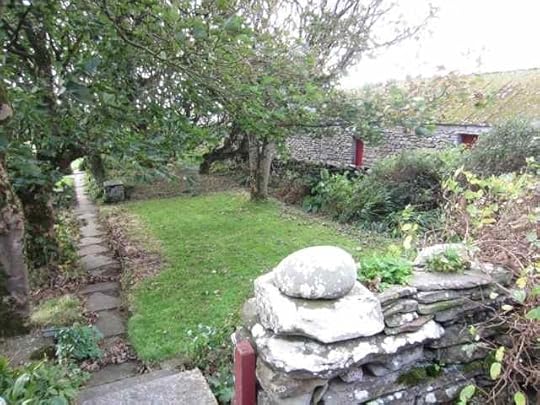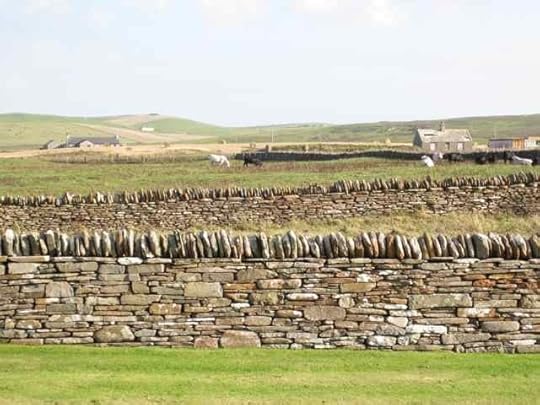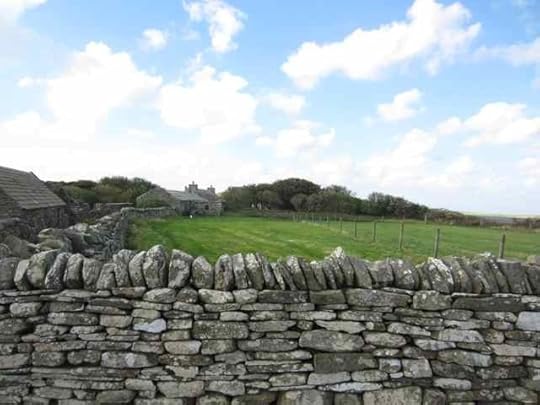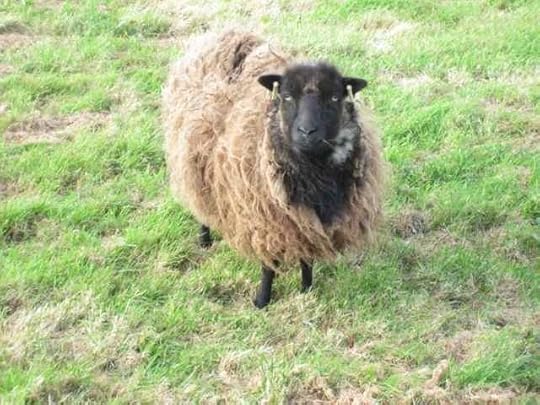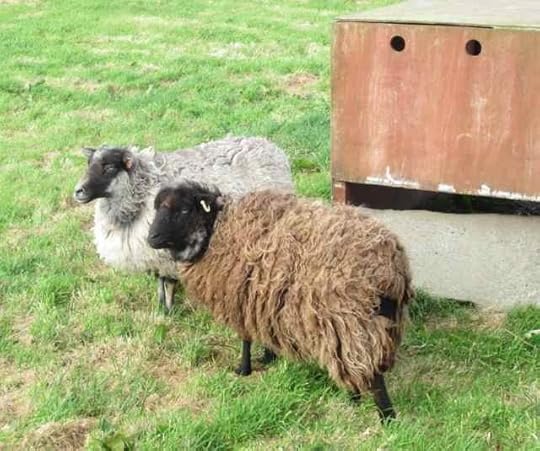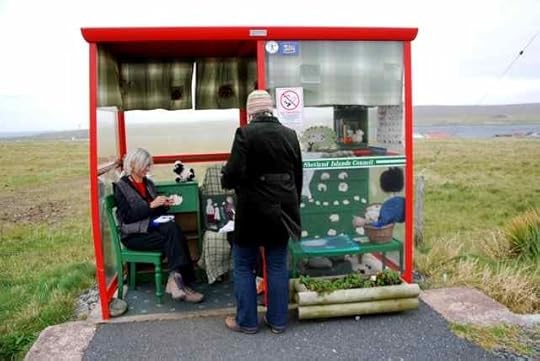Deborah Robson's Blog, page 5
December 13, 2013
The Kirkwall museum, part 1 - tools
Did I start this post a month ago? I did, indeed. Life has been intervening. I still have a pile o' deadlines that I need to pay attention to. This morning, however, I will give myself the treat of starting this particular post about:
The Orkney Museum in Kirkwall, Orkney
. . . another place where I only managed to get an overview. But wow, the bits that I caught! It's a quirky museum, built into what used to be a house, and you go up, down, and around to get from one space to another. It would be easy to get lost, and that reinforces the sense of discovery. It's like there are magic staircases and hidden doors in walls that lead to other worlds.
I'm not finding a picture in my collection of the real entrance to the place, which I'd like to show, but there's one here, along with a lot of other good information about the site. Access to the museum is through that lovely archway. Step through it into the courtyard for the first view in my photo collection:
The rest of the photos will be out of sequence, and, except for the final handful (in the next post), all relate to textiles. I decided to show you first tools (today) and then textiles (next post, I trust . . . it's almost complete). And then a couple of glimpses of favorite non-textile items. You could spend hours in this museum with a given focus and come out stunned and entranced (time for a restoring cuppa across the street and down a bit at The Reel).
Whereas in many museums textiles are either an afterthought or are sorted out into their own basement corner, fiber exists as a recurring theme throughout the Orkney Museum, which is organized by time periods. This panel comes from one of the final rooms, but the combination of modern and historic (the rune image, graphic motif, and stories of individuals within the social and economic context) echoes the integration of textiles throughout the distinct eras.
The inset photo of the woman shows Hettie Scott. Born without arms, she was an accomplished embroiderer, using her feet. A bit more about Hettie in the next post. The information in this museum continually blew my mind. You could easily spend several days in it. I had a quick trip through—somewhere between one and two hours. (Definitely lost track of time.)
Tools
As I've mentioned before, Orkney's history is very deep. The tools and stories begin with bone implements, plant dyes, and upright looms.
Bones and stones: amazing materials out of which to make functional tools.
The spindle whorls are stone. The batten, next to them, was made from whalebone, likely used for weaving on an upright loom, and dates to the third century BCE (not all that old for this part of the world!). The next two pointed tools are awls; the small item just right of the center is a bodkin, with a bobbin below it. On the right at the far back are needles, and in front of them are three pins.
More spindle whorls—as I recall, these were in the Pictish section—about the fourth century CE.
In the same area there was a whorl inscribed with with ogham writing, used for recording both Pictish and Irish texts. Although found in a Pictish site, the language here is Irish.
I'll step forward a moment to the exhibit of contemporary Orkney craft, which is extraordinary, to show a piece of jewelry that you can buy, inspired by that spindle whorl:
That's a Sheila Fleet piece. There are several fantastic jewelry producers in Orkney.
Calling John Mullarkey! (I thought of you the instant I saw this, John.) Here's a bone weaving tablet:
It was in the Viking area, along with more whorls, needles, needle cases, and other treasures. It is exquisite. I want a whole set of them. And I'm grateful to have cardboard weaving tablets. They work, although with less flair and grace. (There will be another note, and a link, about tablet weaving in the textiles post.)
Moving forward a few centuries, due to lack of time. . . .
This iron spinning wheel was made by a blacksmith named, I think Robert Dick. (The last part of his surname was hidden behind an artifact.)
A more typically constructed wheel for which I forgot to snap a picture of the identification information (Liz?):
These were in an exhibit of the linen industry of the late 18th and early 19th centuries.
And this amazing wheel was in the drawing room of Baikie House (remodeled 1820), representing the building that now holds the museum when it was a residence.
I love the contrast between the ornate carving and the slatted treadle. Was the treadle original, or perhaps a replacement? (This said by someone who's worn out a treadle and needed to replace it.) Perhaps not. The text says the wheel was purchased with the help of a grant and was "influenced by the Arts and Crafts Movement. Made by John Logie for Lady Eliza D'Oyly Burroughs of Trumland House in Rousay."
And now I need to take a breath before we continue by looking at sample textiles in the museum. (I love the rug in that photo of the wheel just above. There's fiber work hiding everywhere, including in plain sight but not noted on the interpretive panels.)
More to come. . . .
I don't think I've mentioned yet that this splendid institution does not have an admission fee. It does have a lovely small shop with well-selected items for sale. . . .
December 9, 2013
Washing wool (still, or again?)
We'll pick up the other threads I've been talking about again soon, but I've had some deadlines. Some of them involve editorial and layout work and some involve washing wool for next year's workshops. The wool-washing is an ongoing task with intense periods of activity: in order to do it, I have to be home, I have to have at least a good chunk of a day free, and I can't wash more fleece than I have drying space for. That means I wash for a while, then take a break. Now I'm washing again. Still. Whatever.
I've posted to Twitter and Facebook over the weekend about some of the washing, and a couple of questions have come up: several people requested fleece photos! and a couple of others asked how I manage to clean up after a washing session in the bathtub.
First, though, I need to note that I now have almost enough racks that I don't have to stop because I've run out of drying space. I have been collecting a particular type of sweater dryer for a while, as it comes on sale. I have one more to add to the stack, for a new total of 12. (Used to be 8.)
When I'm washing, I make sure to wash fleeces that can be easily distinguished from each other. That means that I can, if necessary, put two dissimilar half-batches on the same rack (fourth from the top). I stopped washing yesterday soon enough that I have one small batch by itself (second from the top). That likely won't happen often!
The rack contains, bottom to top, Corriedale, Shetland, and three Karakul fleeces (they're all from Letty Klein's flock in Michigan; the white is Sera, the two-tone gray is Rhena; the silver-gray is Arial).
Here are what two of them looked like in the tub. First Rhena, with her distinctive light tips:
Then Arial, still variegated but much more subtly so:
By the way, that is a whole 4-pound (1.8 kg) fleece in those trays. Karakul is quite low in grease and I can get more in a batch than I can with higher-grease wools. I can also use smaller amounts of Power Scour. I do tend to stick with my regular routine of two short soaks, two washes, and two rinses, regardless of breed, partly because then I can wash on semi-autopilot and partly because even when there isn't much grease there does tend to be dirt, due to the sheepy preference for living outdoors. The dirt succumbs to the rinses. And two washes are my baseline, with three for fleeces that need additional attention.
Karakul fleeces are interesting in part because they are so low in grease that the locks separate very easily, almost falling away from each other as I pull out handfuls to put in the trays. And in this case, I found a few locks in the bottom of the bag as I was starting the second wash, and I was comfortable just throwing them into a tray and letting them make do with that single wash and the following two rinses. They'll be fine. There was enough dirt that I wouldn't have wanted the whole fleece-washing process abbreviated in that way, but for a small piece? No problem. (Michigan dirt washes out far more readily than some Oregon mud. These fleeces were both easy and satisfying to clean up.)
And now for a few close-ups of the drying wool. Rhena (Karakul):
Arial (Karakul):
Sera (Karakul):
Note that I keep tags with the wool at all times. Some are the label sheets that I'll use to track and identify the fiber throughout its time in my keeping. Some are shepherds' tags, like Letty's note above. In the first photo, you can see a sheet of labels sitting next to the Corriedale on the bottom racks; just above those, there's a handwritten note on the corner of the first Shetland level.
Speaking of which, here is the Shetland, a moorit (brown) grown in Maryland:
And on the bottom is the balance of RUP 1022, from Rupperts in Pennsylvania. I'd washed most of this fleece in August, before I needed to ship a portion of it to Maryland for the Explore 4 workshop that took place there at the end of my travels in Scotland. I needed to get the rest of it clean. Keeping all the processes in order is key to success at wool management.
Now about cleaning up.
When I'm washing wool in the tub, we have one of the cleanest bathtubs on the planet. At the end of a day's washing session, these are my tools:
Bon Ami, which is the mildest and most effective cleanser I've found; a scrubber rotated out of service in the kitchen (wear 'em out there, then move 'em over here; next stop really grubby assignments); and a cup that's great for rinsing quickly once I've scrubbed. The surface of that scrubber works well in the kitchen, and is arguably the ideal tool (even in its worn state) for the tub as well.
I don't know where we got that cup, but it's perfect. It does have a few tooth marks in it. Our Border collie Ariel liked the feel of chewing plastic. She was quite trustworthy about not damaging other things (once she got past puppyhood). However, she was a smart dog and did figure out how to open the bathroom door by turning the knob. The evidence endures.
Ah, if she'd only had opposable thumbs, imagine where she could have gone! (I'd have had to hide the car keys.)
Another question posed over the weekend relates to how I keep the grease from clogging the drains. It hasn't been a problem, and I'm guessing that's because of the way that I wash. The grease is dissolved and the washing fluids are all flushed through the waste system in warm water every 20 minutes. There are fairly small amounts of grease at any single time, and I suspect that the Unicorn Power Scour I use is helpful in keeping that grease in solution and moving along (surfactants actually bond with grease molecules, with the result that the combination can be rinsed away). The final flushing of the plumbing system happens when I'm cleaning the tub. I use modest amounts of water, but I keep them moving and monitor the temperatures.
We occasionally have clogged drains. But we've never had one when I've been washing a lot of wool. (Do not grind up potato peelings in an in-sink garbage disposal unit. Compost them, or put them in the trash. Repeat: do not. . . .)
And now there are more fleeces awaiting my attention. . . . (And more blog posts to write! Some of them about dogs.)
Ariel (1994 – 2009):
November 29, 2013
Mainland Orkney: Kirkwall as a home base
Kirkwall is the largest community in Orkney, and is located on the largest island, called Mainland. It makes a terrific base of operations. As with everything I'm writing about pertaining to this trip, I can't do it justice but I can offer glimpses.
Here's a view of Kirkwall, with Saint Magnus Cathedral prominent:
I can't get the cathedral's own website to load right now (it may later when I'm not writing at the coffee shop—indeed, it did), and my photos of the interior seem to be AWOL. I'll have to go to Orkney again and take more, won't I? (It's a tough job, but not one I'd want to delegate.)
For the most part, I focused on early history and sheep-related topics during my time in Orkney. There's so much there that the only way not to go nuts trying to see and do everything is to have an organizing principle in mind for the visit. Even with personal guidelines (or, rather, boundaries), I found it was only possible to do reconnaissance and think about what I was seeing that would shape a future visit. (The same was true for Shetland.) The cathedral in Kirkwall was outside my primary scope, or so I thought. But it was so conveniently located (and highly recommended by a friend) that I did get there just before I left, and was very glad to have done so.
But back to getting oriented in part of Kirkwall.
Here's the street that was the focus of my days there. It is, obviously, better constructed for the use of pedestrians than for cars. And in windy, wet weather, it's more sheltered than other parts of the nearby environment. I'd give names of streets, but they seem to change every few blocks. Walking around is easier than giving directions with names on them. I'm pretty sure this section was called Victoria Street. Other parts of the same continuous route were called Albert Street, and one section might have been Castle Street. (In the other direction, the road turns a corner and becomes High Street, and then Old Scapa Road, and then . . . on foot, it's not confusing at all.)
A number of narrow passageways lead off that primary street. One I photographed is called Gunn's Close. As I mentioned in an earlier post, although I'm a mix of heritages, one predominant family line is the Robson one, a branch of the Gunn clan, which was resident in northeastern Scotland and . . . Orkney.
A similar narrow, but dead-end, passageway on the other side of the main street and a little bit farther from the cathedral led to the self-catering apartment where I stayed. "Self-catering," for those not familiar with the concept, involves renting a space that has cooking facilities and where the itinerant residents do some of the housekeeping to prepare for the next inhabitants (i.e., "leave it as you found it, to the best of your ability"). The arrangement has the huge benefit of permitting easy, comfortable, and economical meals. It isn't necessary to eat out unless you want to.
Just down the street was Lucano, however. It is an extraordinary Italian restaurant, and a delightful place for a lunch and a dinner. The sort of place you do go back to.
As you may have noticed, parking along the street is scarce and short-term. Basically, you can drive along the street to deliver things (like your luggage) or pick them up (if they are, for some reason, too bulky to carry). Thus the car got parked a block uphill, on another street that was adjacent to these garden plots.
The view from there of Kirkwall (and beyond) was lovely.
There are larger roads running through the area, and if you walk from where I stayed back up toward where I took the first photo, you will find a couple of supermarkets, including a Tesco. If you're walking from Victoria Street, you can use trips destined for Tesco as an opportunity to see what happens if, for example, you walk down Gunn's Close.
When I was at the Tesco in Kirkwall, I noticed KNITTING in one of the refrigerated cases.
This is apparently not unusual. But it was one of my first tours of a Scottish grocery store on this trip, and while I ultimately got the hang (more or less) of how they were organized and how things were packaged and what brands were associated with what products, it was comforting (if also a bit startling) to catch sight of "the big knit" in a cooler. It turns out that "the big knit" is a very cool thing even when it's not refrigerated.
I found several types of SHEEP (only one is pictured here) in another aisle.
Farther down what I came to think of as "the street," although there are many others, is The Orcadian book shop, a fine place.
Look what I found there—see the asterisks (it was a fine place even before I made these discoveries):
Another place to visit was R. A. Finn, where I missed out on some hand-dyed North Ronaldsay yarn because I thought it would be there the next day (it wasn't) . . .
But I did get a skein (now two balls) of marled North Ronaldsay yarn to play with.
And then there's The Reel. Also within walking distance. A great coffee shop with free wifi. An easy place to hang out. (There was wifi in the self-catering unit, but The Reel's was more reliable, if only available when the place was open.)
AND MUSIC.
I bought a CD—Jennifer and Hazel Wrigley's Idiom. Except for the need to conserve money for wool, I would have bought more. I'll have to go back, right?
Although I'm not done talking about Kirkwall yet (the post on the museum is in process) and we haven't gotten to North Ronaldsay, which was also part of the Orkney section of this adventure, I need to mention the last night in Kirkwall, just before the overnight ferry trip to Shetland. The ferry leaves Kirkwall a little before midnight. It's good to get in the car line about 10:30 or 11. What to do to stay awake and happy until it's time to play the ferry game?
Leave the car somewhere and walk in the early evening toward the welcoming lights of the white building housing The Reel.
Tea, a light snack, and an open music session make for a sweet departing point.
___
Next posts will backtrack a bit, for the sake of The Orkney Museum in Kirkwall and the fine and amazing and wonderful and windy time on North Ronaldsay.
___
The new-to-us pup now has a new name: Tam.
And the approval of our already-resident Border collie, Ceilidh.
More on that soon, too.
November 16, 2013
Mainland Orkney, and the Boreray boys (plus a new dog note)
The travel notes continue. I'm skimming the surface, and still there is so much to say. . . .
The next series of posts will be about mainland Orkney. (To allay some confusion: I was in mainland Scotland; also in Orkney, where the largest island is called Mainland; and then in Shetland, where the largest island is called Mainland.)
While on mainland Orkney, I got to visit Jane Cooper and her Boreray boys:
Jane recently moved to Orkney and is getting settled into her home there, new to her and now with sheep.
Borerays are one of the rarest breeds, and are one of two rare breeds that originated in St Kilda (in case you're reading this in a library, that site loads with an audio clip of sea sounds), a group of islands in the North Atlantic west of the Hebrides. (The other breed from there is the Soay. The Rare Breeds Survival Trust's PDF about Borerays is here.)
These are just little guys. They're a bit skittish, but they can be enticed to come closer (temporarily) by food. They're growing fast. I'll bet Jane will be nostalgic looking at these photos, which were taken not so long ago!
It was great to see Jane again. We met at UK Knit Camp in 2010. Jane has been the instigator, in close collaboration with Sue Blacker, of the Boreray yarns that have been coming from Blacker Designs. Having collected Boreray fleeces from far and wide for those mill runs, it's only fitting that Jane should now have her own Boreray sheep. And I was delighted to be able to make this visit. Thanks, Jane!
To celebrate these special yarns, Liz Lovick designed a special pattern for a shawl or scarf. There's a lot of history and story and delightful creative energy at that post of Liz's that I linked to about the pattern.
Next I'm working on posts about Kirkwall, which was "home base" during most of the Orkney days (except for the ones I spent on North Ronaldsay—and Liz is responsible for the extraordinary time I had there! more soon).
But for now, we can just enjoy these charming fellows and all those lovely related links.
___
P.S. We th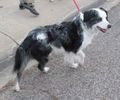 ought we had a name for the new dog, but it's not quite sticking. He came to us as Baxter, yet he's really soft for a Baxter; it just doesn't fit him and doesn't roll off our tongues easily when we look at him. We thought River, but that's a little too soft, even though it has the same cadence, which is a plus. Oh, the matter of names! As he goes to the vet, gets a microchip, and so on, changing his name will get more complicated the longer it takes us to find out what he wants to be called in our family. Sholmet, because he's white-faced? (Not quite a good call name.) Rakki, because he's a dog? (Too percussive for him.) Wash? Maybe. Tam? Also maybe. Spark. . . . Speck. . . . Fendy (meaning "seaworthy"). ?!?
ought we had a name for the new dog, but it's not quite sticking. He came to us as Baxter, yet he's really soft for a Baxter; it just doesn't fit him and doesn't roll off our tongues easily when we look at him. We thought River, but that's a little too soft, even though it has the same cadence, which is a plus. Oh, the matter of names! As he goes to the vet, gets a microchip, and so on, changing his name will get more complicated the longer it takes us to find out what he wants to be called in our family. Sholmet, because he's white-faced? (Not quite a good call name.) Rakki, because he's a dog? (Too percussive for him.) Wash? Maybe. Tam? Also maybe. Spark. . . . Speck. . . . Fendy (meaning "seaworthy"). ?!?
Does anyone know a good word for "happy" in some semi-relevant-to-our-lives language? He has a very optimistic outlook on life, strong even yesterday, which involved immunizations (one did sting a lot), microchipping (which took two tries), a complete physical including blood draw for heartworm check, treatment for mild yeast infections in both ears (drops will be ongoing for a while), and THEN getting stung by a nasty flying INSECT! Poor pup! But pat him (or even just look at him) and he smiles.
November 13, 2013
New to us: one slightly used dog
As of about three hours ago:
Ceilidh thinks he's okay. This is a pretty big deal. She is very "soft," but doesn't like to be pushed around. He can take a hint. (Jak, our foster, couldn't.)
In fact, even when it's hard not to step on her or body-check her, he doesn't.
We don't know what his name will be. He came with a name (Baxter), but we're not sure that's what he'll be called in our household. We're pretty sure it isn't.
November 11, 2013
Retreat (with wool) on Maryland's Eastern Shore
The Scotland, Orkney, and Shetland travel notes will continue, interleaved with real-time updates. There's so much to share. . . .
I'm home again, and while I wasn't ready to leave the places where I traveled, I was ready to be in a familiar environment. Greetings from the family, both two-legged and four-legged, were enthusiastic and welcoming. I need a haircut. I need to deal with the mail. And so on. But right now I'm taking a breather from the mail to remember the wonderful time in St. Michaels, Maryland. (I keep wanting to put appropriate apostrophes into the names of places, even though the Powers That Be have determined that they don't belong any more.)
And a reader with ties to the Eastern Shore has asked for pictures and notes about that event, which just pushes it to the top of the queue (before life stampedes along again). We had a great time, in a beautiful location, with a range of interesting fibers.
The breeds we covered—all locally sourced—were: Corriedale, Hog Island, Jacob, and Shetland.
Here's a view of a St. Michaels harbor, as seen from the Town Dock restaurant. They have excellent seafood, of course, and they also had superb grilled veggie ravioli for me. (Just listen: "jumbo raviolis filled with grilled red peppers, onions, asparagus, mushrooms and Ricotta cheese served over our own pesto cream sauce and garnished with roasted walnuts and Parmesan cheese"—the sauce wasn't too rich, and the presentation was exquisite.)
The harbor saw traffic from different sorts of boats than I'm accustomed to looking at (which are fishing boats, mostly). However, there were a couple of groups of kayakers as well.
This is the inn where we stayed for the workshop. Several local folks joined us. The inn has other buildings. This is the main (old) house, where my room was on the second floor and our workshop space was on the first floor.
Lucy is dog-in-residence.
The views from all directions are stunning.
This is the breakfast room, in which we held the workshop. We did need to condense our workspace every night in preparation for the morning meal, but it was a lovely room in which to spend our days. There's a lot to be said for views and natural light.
In the Explore 4 workshops, I pick out a set of breeds to cover that will offer opportunities for comparing and contrasting wool types; that will shed light on some of the history of sheep; and that will give us lots of opportunities to play with different preparation and spinning techniques.
The Corriedale fleeces that we had showed variety within the breed, which we talked about. Much of the "retreat" involves just spinning and trying things, with me there as a resource once I've presented some basic material. It's both relaxing and instructive. There's nothing like experimenting to promote a sense of learning and accomplishment (I do love seeing what different things I can do with a particular fiber). Obviously, the crimp patterns, lock structures, and other qualities of the two Corriedale fleeces that we had were quite different. Yet in our hands, they were both quite distinctively Corriedale.
The second day was Hog Island, which I'll come back to at the end. I pace the sequence of wools in the workshop in particular ways, so the experiences build on each other.
The third day focused on Jacobs. We talked about the differences between commercially prepared fiber and starting from fleece; between U.K. and U.S. Jacobs; and between one flock and the next. We had two contrasting fleeces to work with.
Some people decided to sort the colors: the question, of course, is where one leaves off and the next begins! But the resulting range of harmonious shades can be utterly charming. (This was Haven's fleece.)
Then there's the temptation to "spin it as it comes," a valid choice that actually turns out to have its own challenges. (This was Bess's fleece.)
After providing background information in the morning, I spent the afternoons spinning along with everyone, fielding questions, offering perspective, and sometimes sharing discoveries I was making as I worked with the same fiber that everyone else had in hand. In the evenings, which were technically "off," I knitted or wove small swatches of some of my samples. The sizes of the samples varied, depending on how much I'd gotten done, and I still have my Shetland swatches to knit because on the final night I was packing up the workshop materials, instead of playing with fiber.
Here are a few of my swatches:
This was half of my room. I had a private bath, just to the right off the hall at the top of the stairs. It was great to have enough room to organize each day's materials in advance.
The windows by the bed did look out across the bay, and one morning I caught a well-lighted freighter going past just after dawn. The picture is textured because I shot it through the window screen. Sunsets were gorgeous, too.
On some lunch breaks, I walked around. I was tempted to keep spinning, but the weather and the location were too pretty not to discipline myself to get outside for a while. This photo is looking toward the inn (the hammock is between the inn and the shore).
I love collecting textures. . . .
And textiles. . . . Even better is textures AND textiles.
There were a lot of good places to wander around, and even take a decent-length walk and still get back in time for the afternoon session.
This is a tree that I mentioned to my sister. It had fallen into the water, and I have more pictures of it. It was a grand and beautiful thing, with growth patterns that indicated a challenging life that had been made whole by the way it accommodated and incorporated what had happened in its time on the shore. At different times of the tide, more or less of it was revealed.
I didn't quite figure out who this bird was. It wouldn't let me get close enough for a decent look, and I didn't have any binoculars with me.
It's obviously in the heron/egret family, and has a yellow-orange bill, but I couldn't quite pinpoint it with the bird guide that was at the inn. I suspect someone else will be able to identify it for me faster than I can currently get the Cornell ornithology site to load! (I'm at a coffee shop on a slow, and much in demand, connection.) I'm kinda guessing it was a Great Egret, not a common sight where I've done most of my birding (Colorado, Washington state, and Alaska).
Because of the season, the trees were turning (as you can see above) while the gardens still offered a bounty of bloom:
This little beauty was tricky to get a photo of!
Lots of splendid things to see.
The whole experience was restorative and productive for me, and according to what they said it was the same for the participants. That's the goal.
And now to end with a little bit about Hog Island, a rare breed that has a close historical association with the area because the sheep developed on an island off the Virginia coast, just south of Maryland's Eastern Shore.
I'll be the first to say that Hog Island fleeces are not ones that a handspinner would initially find appealing, given a range of choices. And they are a little tricky to handle. That's why we did them on day 2: I wanted to start off with something a bit easier to get everyone warmed up. I don't have my samples of the exact fleeces that we worked with handy, but this is a fairly typical Hog Island lock:
I didn't have my standard background, with its reference line of 4 inches/10 cm, handy, but that lock is about 2.5 inches/6.5 cm long. It's matte, and a little flat, and while there's a lot of crimp in there it's disorganized (not a problem for the yarn or textile, but the visual appeal of the locks isn't high). And yet. . . . This was the workaday wool for a group of people for a number of years, and spending some time with it can reveal a lot about history and human ingenuity.
And once we got into processing and spinning it, we managed to produce some yarns and samples that made us think we'd like to seek out more!
Above are samples of our four Hog Island fleeces, two light and two dark. The bit at upper right is a tiny section of Corriedale, to show the overall warm nature of the Hog Island whites: they differed from each other, too, with white #2 being a lot creamier than white #1. In the blacks, black #1 was a nice solid dark and softer than black #2, which nonetheless had a fantastic sturdy and tweedy texture. As I was working with them, I could see white #1 or black #1 as being especially well suited for making knitted garments with texture stitches—like cables or knit/purl combinations—because the body of the yarn would give them a bas-relief quality. White #2 seemed to want to be a lighter-weight garment (it was the warmer white), while black #2 would make a fantastic jacket. It was a bit coarse for more delicate applications.
Interestingly, many of the participants' best samples of several of the breeds we covered were made by spinning directly from gently opened locks. Zero tools other than hands and a spinning device. (We also talk about various tools and approaches, from the inexpensive and low-tech to the fully equipped textile workshop's array.)
And so we learn. . . .
Right now, I'm thinking about fibers for next fall's East Coast retreat, and am deep in the throes of deciding on breeds (I think I've got that settled) and gathering fleeces (final breed decisions depend on this step) for the retreat in Washington state in March 2014.
November 8, 2013
It's good to be home
I've had another blog post almost done for several days. There are more that I need to write.
Meanwhile, even after a wonderful trip it's good to be home.
November 4
November 5
November 6
November 7
It's time to take the dog for a walk. She wakes up really fast when she hears the leash jingle. Despite the somewhat deceptive and yet fully accurate appearance in the photos above, she is a Border collie. And in obedience practice on Wednesday night, she was amazing. I just find it very difficult to get good photos except when she's napping.
More soon.
October 26, 2013
Orkney - Corrigall Farm Museum
Where Skara Brae shows how residents of Orkney lived 5000 years ago and where Kirbuster was built in the 16th century (and expanded in the 18th), Corrigall Farm Museum brings the progression of home-and-farm sites I visited up to the late 19th century: quite a leap again, even though I also needed to keep in mind that Kirbuster was still used as a home concurrently with establishment of Corrigall.
Many aspects of the buildings' shapes, functions, and construction carry forward earlier themes, with new ideas added, including chimneys.
The sizes, shapes, configurations, and some details evolved. The stone roofing here, sometimes with turf on top, is wonderful and shows up all over Orkney.
Peat, cut and stacked against the winter.
More careful stonework: a doorway to the barn.
Within the barn, I was surprised to find a familiar configuration of stalls for dairy cattle (now storing other items) and a drain channel in the floor, reminiscent of the way the main barn was set up at Windy Knoll Farm in Illinois in the mid-twentieth century. That was a larger barn, and made of white-painted wood, but I felt as though I recognized this space as soon as I walked into it.
In the main house, there was a big oven/kiln. As with Kirbuster, I'll need another visit (and background reading) to really understand some of the components of the way of life. But look at that amazing ball of rope, I think made of straw:
Here's a straw bikko, or dog, constructed at the end of the harvest time.
Large netting shuttles, with twine in place, and more wonderful ropes, of different kinds. Rope is an essential tool of life that we certainly manage to forget about (or ignore) in these days of computer cables and duct tape. Where would we be without rope?
A closer view of one of the roof combinations, sod on stones.
This is the entry to the house: it's the kitchen area, and the chickens enjoy the grain that's scattered around the stones where it's ground into flour.
Not everything was work. There was music, and there were dogs, and there was art.
Although they could have wandered farther, the chickens seemed to stay in the entry area of the house. . . .
. . . it was probably far more interesting to them than the sleeping and sitting areas. The cat, however, made herself at home everywhere.
There were lots of textiles, many of them worn enough that they were not too "precious" to be on display and handled by visitors. Both originals and reproductions hung on pegs, were neatly folded in cupboards. . . .
. . . and lay on the floor.
Up in the rafters, I saw two niddy-noddies for winding skeins of yarn. Here's one of them.
It's true: I wanted to take down one of the niddies (also called reels) and use it.
The other sections of rafters and tops of items (like the cupboards) in the main room also held carders, lazy kates for spinning-wheel bobbins, and other textile tools.
A bookshelf displayed many titles in bindings that resemble those of some of the books my sister and I now have.
The family at Corrigall apparently liked to read, and a number of the books could have come directly from the shelves at my grandmother's house.
Another room held more family items: a cradle, child's and adult's chairs, more carders, a basket of wool. . . .
. . . a skein winder and a spinning wheel (with a few missing bits), plus a small expanding swift on the shelf behind. . . .
. . . and the cat who goes everywhere.
A real plant, of a somewhat rare type, from which cuttings are available to those who may be able to cultivate offspring.
In the room that is now a small shop and information center, there's a wonderful big old loom.
And a quill winder. You can also see here some of the pegs set into the back of the loom to form a warping frame.
While there were an amazing number of items on view, it was possible to focus on individual objects in turn and see their elegance and simplicity, along with the dignity that comes from having been well used. As, for example, these two reeds that may have been fitted in turn into the nearby loom. They were made, not manufactured.
And this shuttle, broken in several ways now, smooth and shaped when it was originally carved and then even more during the thousands of hours when a weaver held it, threw it through the shed, and caught it at the other side . . .
. . . then turned it to send it on the journey back through the next shed to the other side, growing—one thread at a time—all the cloth that would be needed by and put into use in a household: for sheets, towels, clothing, and more.
At both Kirbuster and Corrigall, we were lucky to find people as well: in each location, we met a guide involved at all levels with the museum who was willing to share his insights and knowledge. At Corrigall, that was Neil Leask, who, when he's not working, is developing a personal collection of treasures and their stories and the skills that go with them, some of which he shares with visitors at the museum, to keep both the memories and the living knowledge active. His young children will benefit in the future from his efforts and enthusiasm, as the museum does now. We thought we were about to leave, and then another hour of fascinating discourse ensued!
I felt lucky to be in Orkney during the open season for the farm museums (just barely), and I look forward to the possibility of going back for more. I'll know not to have a very tight schedule, which, fortunately, I didn't—I wasn't able to see anywhere near as much as I wanted to, but no visit that I made was rushed. That was true of this whole adventure. . . .
October 25, 2013
Orkney - Kirbuster Farm Museum
Several sites in Orkney allow a visitor to see the progression of human habitation. The earliest is Skara Brae. After that, we went to Kirbuster Farm Museum, a massive leap forward in time but one in which the types of structures and living spaces implemented at Skara Brae were still evident.
Kirbuster originated in the 16th century. Where Skara Brae is 5000 years old, Kirbuster came into being about 400 years ago as a croft (smallholding, or farm) house. While typical of its time in some respects, it was larger and more diverse and the domicile connected with more land than most structures of its era. It was also expanded in the 18th century and was lived in until 1961, so many portions reflect inhabitation from the 19th and 20th centuries.
Here's a glimpse of some of what's there. . . .
One interesting thing about the two farm museums I visited in Mainland Orkney is that they are so approachable. Some of the items are historic and some are replicas, but all can be moved among and "felt" in place, as if the spaces were still in use, perhaps by you who are moving within them, imagining what it would be like to carry out the activities of daily life inside these walls and and among these fields.
The ancestral stonework skills endured—prompted, no doubt, by the ready availability of stone. This is an outbuilding near the entrance: I think it was a drying house or type of kiln, but am open to correction. Having recently been at Skara Brae, I was more focused on its construction than its function.
Here's the inside of the house, looking back toward where we entered, from a vantage point near the hallway to the later addition. That great block of stone is the hearth. The pole hanging down is attached to boards in the opening of the roof that lets the smoke out. More about that in a moment.
Here's the hearth and its burning peat fire, with strings of fish drying in the heat. Yes, real fire and real peat. While it was smoky, it was nowhere near as bad as you'd think (for an open fire burning without fireplace or chimney) because of the ingenious draft system.
The hole in the roof (proto-chimney) is amazingly effective—more so than the smoke-removal options in many later houses of this area and elsewhere. The boards attached to the pole can be adjusted (by angle and position) in response to the direction of the wind to make the draft most effective. I have some photos of the opening in the roof, although they're not terrific.
This is looking up into the hole. The board extension controlled by the pole is in place on the upper edge of the hole that the photo is looking toward. It could be shifted to the other sides and slotted into place.
The hole isn't just a hole. It's pretty carefully and ingeniously devised and built. Here's another view of the portions that are in the dark in the photo above.
The point is: this place is rustic, but people knew what they were doing when they put it together. It was not in the least haphazard, and when the winds blew and the rain fell, the thick walls and adjustable heating system provided relatively spacious and functional shelter.
Textile crafts were in evidence, if not actively progressing (but wait for the end of the post to see a much better representation of the fiber heritage).
A wheel that needed cleaning, a flyer, driveband, oil, adjustment. . . .
Old wheels like this always make me wonder if they're salvageable.
It was very "gray" in the fiber-processing realm, but at least the elements were present. The drying fish over the fire were pretty dusty, too.
The neuk (nook) bed is strongly reminiscent of similar stone enclosures at Skara Brae.
My next photo's a little fuzzy, but the style continued into the new wing and its box beds. The materials from which those beds were constructed were different and the styles of bedding changed. But the type of resting place would have felt familiar.
The new part of the house has a very different feel, but there is continuity. Shawls hang on a peg rail:
Inscribed names record a lot of family history—the information on these pages reflects events of the mid-nineteenth to mid-twentieth centuries, with an emphasis on the late part of the nineteenth and early part of the twentieth:
Like Skara Brae, this was a home.
At the back end of the property is a long building with a lot of tools. I'll show just a few. Two wagons, of similar design but from different eras:
Out back of the extension is a walled garden area with an orchard and flowers.
It's even more remarkable than it looks in this photo, given the general Orkney landscape—this taken nearby:
And this of the croft context:
And that brings us to the most interesting fiber detail of the Kirbuster visit:
There were two North Ronaldsay sheep in an adjacent pasture. I have to show you both.
At both Kirbuster and the following museum (next post), the curator/attendants offered fascinating insights into the buildings and objects in their care. They're obviously and justifiably proud of these resources where history can be touched and felt and experienced in continuity with the present day.
October 14, 2013
The Unst bus shelter
The chronology of posts for this trip is interrupted now for a glimpse of yesterday's journey to Yell and Unst, the northernmost islands in the Shetland group.
Thanks to Jeni Reid for the photo of me knitting in the Unst bus shelter. The shelter has been decorated this time in honor of the North Atlantic Native Sheep & Wool Conference, which is what I'm currently participating in.
We enjoyed a pleasant stop en route to our more official duties, along with a short knitting spell. (I got a lot of knitting done on our bus ride: I completed two demo swatches while watching out the window.)
If I had ever made a lifetime "bucket list," visiting the Unst Bus Shelter would have been one of the items on it.
I look forward to visiting it again before too long.
Also from Jeni, a she-says "gratuitous photo of sheep":
They look like Duncan Gray's ewe lambs to me (mostly born in May this year), although I'd need to check my notes to be sure of that and of the spelling of his name. Apologies if any of that information is askew. I need to walk down to the museum now. . . . Today is the day of the North Atlantic Native Sheep and Wool Conference presentations, of which one is mine.

